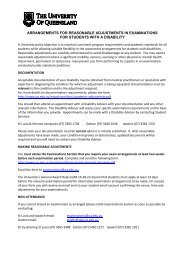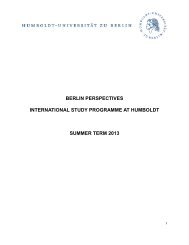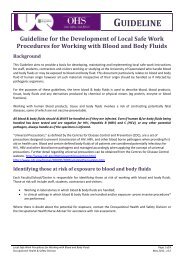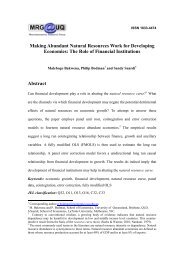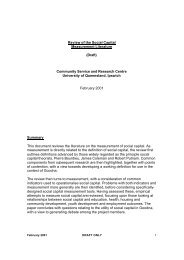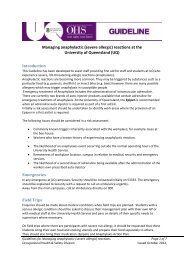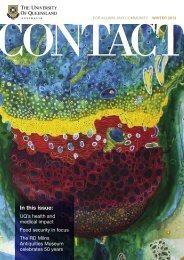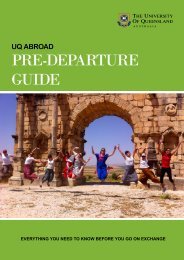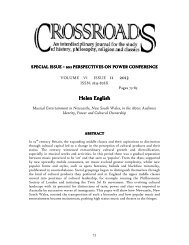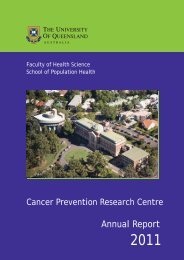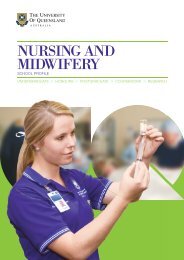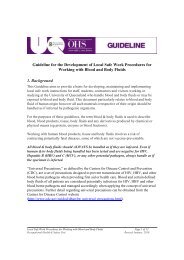Mechanical disruption of seagrass in the digestive tract of the dugong
Mechanical disruption of seagrass in the digestive tract of the dugong
Mechanical disruption of seagrass in the digestive tract of the dugong
Create successful ePaper yourself
Turn your PDF publications into a flip-book with our unique Google optimized e-Paper software.
<strong>Mechanical</strong> <strong>disruption</strong> <strong>of</strong> <strong>seagrass</strong> <strong>in</strong> <strong>the</strong> <strong>digestive</strong> <strong>tract</strong> <strong>of</strong><br />
<strong>the</strong> <strong>dugong</strong><br />
J. M. Lanyon & G. D. Sanson<br />
School <strong>of</strong> Biological Sciences, Monash University, Clayton, Vic., Australia<br />
Journal <strong>of</strong> Zoology. Pr<strong>in</strong>t ISSN 0952-8369<br />
Keywords<br />
<strong>dugong</strong>; mouthparts; diet; <strong>seagrass</strong>;<br />
digestion; mechanical breakdown.<br />
Correspondence<br />
Janet M. Lanyon. Current address: School<br />
<strong>of</strong> Integrative Biology, The University <strong>of</strong><br />
Queensland, St Lucia, Qld 4072, Australia.<br />
Tel: (07) 3365 4416; Fax: (07) 3365 1655<br />
Email: j.lanyon@uq.edu.au<br />
Received 8 June 2005; accepted<br />
30 January 2006<br />
doi:10.1111/j.1469-7998.2006.00135.x<br />
Abs<strong>tract</strong><br />
The cheek teeth <strong>in</strong> <strong>dugong</strong>s are considered to be largely non-functional whereas<br />
<strong>the</strong> oral horny pads are important both <strong>in</strong> mechanical <strong>disruption</strong> <strong>of</strong> <strong>the</strong> diet and <strong>in</strong><br />
convey<strong>in</strong>g <strong>seagrass</strong> through <strong>the</strong> mouth. Particle size distributions <strong>of</strong> digesta from<br />
41 dead stranded <strong>dugong</strong>s were exam<strong>in</strong>ed to <strong>in</strong>vestigate <strong>the</strong> relationship between<br />
degree <strong>of</strong> food breakdown, gut region and functional surface area <strong>of</strong> <strong>the</strong><br />
mouthparts. The <strong>in</strong> vitro ease <strong>of</strong> fracture <strong>of</strong> major dietary <strong>seagrass</strong> species were<br />
compared. The rate <strong>of</strong> food breakdown through <strong>the</strong> gut appears to be more closely<br />
l<strong>in</strong>ked to fibre level <strong>of</strong> <strong>the</strong> diet than to size or age <strong>of</strong> <strong>the</strong> <strong>dugong</strong> and its mouthparts.<br />
Low fibre <strong>seagrass</strong>, for example Halophila ovalis, breaks down at a faster rate than<br />
high fibre <strong>seagrass</strong>, for example Zostera capricorni both <strong>in</strong> <strong>dugong</strong> guts and<br />
<strong>in</strong> vitro. Several structural characteristics <strong>of</strong> <strong>seagrass</strong>, <strong>in</strong>clud<strong>in</strong>g level and arrangement<br />
<strong>of</strong> fibre, and water content, make it particularly amenable to mechanical<br />
breakdown. The s<strong>of</strong>t mouthparts <strong>of</strong> <strong>the</strong> <strong>dugong</strong> are highly modified so that <strong>the</strong><br />
entire oral cavity functions to crush low fibre <strong>seagrass</strong>es. Thus, <strong>the</strong> <strong>dugong</strong> has<br />
developed an efficient method <strong>of</strong> food <strong>in</strong>gestion and mastication that is suited to<br />
process<strong>in</strong>g large quantities <strong>of</strong> s<strong>of</strong>t <strong>seagrass</strong> dur<strong>in</strong>g short dive times. The potential<br />
cost to <strong>the</strong> <strong>dugong</strong> <strong>in</strong> hav<strong>in</strong>g lost its hard dental surfaces is that it has become<br />
restricted to a low fibre diet.<br />
Introduction<br />
Dugongs are large mar<strong>in</strong>e herbivores that feed almost<br />
exclusively on a few species <strong>of</strong> <strong>seagrass</strong> (Wake, 1975; Marsh<br />
et al., 1982; Lanyon, Limpus & Marsh, 1989; Preen, 1993).<br />
Like <strong>the</strong>ir close relatives, <strong>the</strong> manatees, <strong>dugong</strong>s are h<strong>in</strong>dgut<br />
fermenters, rely<strong>in</strong>g on symbiotic organisms <strong>in</strong> an expanded<br />
colon to ferment <strong>the</strong> fibrous portion <strong>of</strong> <strong>the</strong> diet (Murray<br />
et al., 1977; Goto et al., 2004). However, unlike <strong>the</strong> manatee<br />
and o<strong>the</strong>r h<strong>in</strong>dgut-ferment<strong>in</strong>g mammalian herbivores, <strong>the</strong><br />
<strong>dugong</strong> does not show extreme dental development consistent<br />
with a strategy <strong>of</strong> maximiz<strong>in</strong>g cell content release<br />
(Lanyon & Sanson, 2006). Typically, h<strong>in</strong>dgut fermenters<br />
have placed a premium on a functionally effective dentition,<br />
with adaptations that may <strong>in</strong>clude <strong>in</strong>creased size <strong>of</strong> <strong>the</strong><br />
cheek tooth row and/or diverse mechanisms for <strong>the</strong> ma<strong>in</strong>tenance<br />
<strong>of</strong> cutt<strong>in</strong>g edges or gr<strong>in</strong>d<strong>in</strong>g surfaces (Vorontsov,<br />
1967; Fortelius, 1985). Although <strong>the</strong> three species <strong>of</strong> liv<strong>in</strong>g<br />
manatee all have enamelled bilophodont teeth that are<br />
replaced sequentially throughout life via molar progression<br />
(Sanson, 1977; Domn<strong>in</strong>g, 1982), <strong>the</strong> <strong>dugong</strong> has a degenerate<br />
dentition (Lanyon & Sanson, 2006). The simple peglike<br />
cheek teeth <strong>of</strong> <strong>the</strong> <strong>dugong</strong> are relatively small for <strong>the</strong><br />
body size compared with o<strong>the</strong>r h<strong>in</strong>dgut-ferment<strong>in</strong>g mammals,<br />
are simple <strong>in</strong> structure and are composed <strong>of</strong> s<strong>of</strong>t<br />
dent<strong>in</strong>e (Lanyon & Sanson, 2006). In contrast, <strong>the</strong> s<strong>of</strong>t<br />
mouthparts <strong>of</strong> <strong>the</strong> <strong>dugong</strong>, <strong>in</strong>clud<strong>in</strong>g <strong>the</strong> oppos<strong>in</strong>g horny<br />
pads and <strong>the</strong> palate and tongue, are greatly developed<br />
(Marsh & Eisentraut, 1984; Marshall et al., 2003) and may<br />
function not only <strong>in</strong> <strong>disruption</strong> <strong>of</strong> <strong>seagrass</strong> but also<br />
<strong>in</strong> transport<strong>in</strong>g <strong>seagrass</strong> through <strong>the</strong> mouth (Lanyon &<br />
Sanson, 2006).<br />
The high digestibility <strong>of</strong> <strong>the</strong> diet (Murray et al., 1977) and<br />
<strong>the</strong> f<strong>in</strong>ely ground nature <strong>of</strong> particulate matter <strong>in</strong> <strong>dugong</strong><br />
stomach contents (Marsh, He<strong>in</strong>sohn & Spa<strong>in</strong>, 1977; Marsh,<br />
Beck & Vargo, 1999) <strong>in</strong>dicate that some mechanical breakdown<br />
<strong>of</strong> <strong>seagrass</strong> probably occurs <strong>in</strong> <strong>the</strong> anterior part <strong>of</strong> <strong>the</strong><br />
<strong>digestive</strong> <strong>tract</strong>, presumably by <strong>the</strong>se mouthparts. Food<br />
particle breakdown, or <strong>the</strong> amount <strong>of</strong> new food surface area<br />
produced dur<strong>in</strong>g mastication, is likely to be a function <strong>of</strong> <strong>the</strong><br />
crush<strong>in</strong>g surfaces <strong>of</strong> <strong>the</strong> functional mouthparts (Lanyon &<br />
Sanson, 1986). It may also be <strong>in</strong>fluenced by body size (Bae,<br />
Welch & Gilman, 1983), food <strong>in</strong>take (e.g. Sant<strong>in</strong>i et al.,<br />
1983), as well as <strong>the</strong> nature <strong>of</strong> <strong>the</strong> food (Rensberger, 1973;<br />
Bailey et al., 1990), and process<strong>in</strong>g time (i.e. amount <strong>of</strong><br />
chew<strong>in</strong>g). Occlusal efficiency may be def<strong>in</strong>ed <strong>in</strong> terms <strong>of</strong> <strong>the</strong><br />
proportion <strong>of</strong> small particles relative to large particles that<br />
are produced by <strong>the</strong> mouthparts (Lanyon & Sanson, 1986),<br />
and can be described <strong>in</strong> terms <strong>of</strong> <strong>the</strong> particle size distribution<br />
<strong>of</strong> digesta <strong>in</strong> <strong>the</strong> stomach <strong>of</strong> a h<strong>in</strong>dgut fermenter. Reduction<br />
<strong>of</strong> food particle size affects <strong>the</strong> capacity <strong>of</strong> <strong>the</strong> gut for<br />
enzymatic and fermentative digestion, and <strong>the</strong> overall<br />
digestibility <strong>of</strong> <strong>the</strong> diet (Spal<strong>in</strong>ger, Robb<strong>in</strong>s & Hanley,<br />
1986).<br />
Journal <strong>of</strong> Zoology 270 (2006) 277–289 c 2006 The Authors. Journal compilation c 2006 The Zoological Society <strong>of</strong> London 277
<strong>Mechanical</strong> <strong>disruption</strong> <strong>of</strong> <strong>seagrass</strong> by <strong>the</strong> <strong>dugong</strong><br />
J. M. Lanyon and G. D. Sanson<br />
This paper <strong>in</strong>vestigates <strong>the</strong> degree <strong>of</strong> breakdown <strong>of</strong><br />
<strong>seagrass</strong> digesta along <strong>the</strong> gut <strong>of</strong> <strong>dugong</strong>s and relates this to<br />
<strong>the</strong> functional surface area <strong>of</strong> <strong>the</strong> mouthparts and nature <strong>of</strong><br />
<strong>the</strong> diet. We exam<strong>in</strong>e how <strong>dugong</strong>s cope with a fibrous plant<br />
diet <strong>in</strong> <strong>the</strong> absence <strong>of</strong> an effective hard dentition.<br />
Methods<br />
Digesta analysis<br />
Digesta samples were obta<strong>in</strong>ed from 41 <strong>dugong</strong>s. These<br />
samples <strong>in</strong>cluded stomach samples <strong>in</strong> 10% neutral buffered<br />
formal<strong>in</strong> from 29 <strong>dugong</strong>s that had accidentally drowned <strong>in</strong><br />
set nets <strong>in</strong> north Queensland, and now form part <strong>of</strong> <strong>the</strong><br />
Museum <strong>of</strong> Tropical Queensland specimen collection. Skull<br />
and mouthparts measurements were possible for 28 specimens.<br />
Faecal samples were available from two captive and<br />
five wild animals.<br />
In addition, five fresh whole <strong>digestive</strong> <strong>tract</strong>s (four adults<br />
and one calf) were obta<strong>in</strong>ed from <strong>dugong</strong>s that had been<br />
accidentally drowned or hunted <strong>in</strong> nor<strong>the</strong>rn Australia dur<strong>in</strong>g<br />
<strong>the</strong> course <strong>of</strong> this study. These <strong>tract</strong>s were frozen soon<br />
after collection. Digesta samples (up to 250 g) were obta<strong>in</strong>ed<br />
from five regions along each complete adult <strong>digestive</strong> <strong>tract</strong><br />
when available: (1) <strong>the</strong> anterior region <strong>of</strong> <strong>the</strong> stomach,<br />
(2) <strong>the</strong> anterior small <strong>in</strong>test<strong>in</strong>e (duodenum), (3) <strong>the</strong> posterior<br />
small <strong>in</strong>test<strong>in</strong>e, (4) <strong>the</strong> caecum and (5) <strong>the</strong> posterior colon<br />
(=faeces). In <strong>the</strong> calf, digesta samples were available from<br />
<strong>the</strong> stomach and colon only. Ex<strong>tract</strong>ed gut contents were<br />
fixed <strong>in</strong> 10% neutral buffered formal<strong>in</strong>.<br />
Dietary composition<br />
The dietary composition <strong>of</strong> each digesta sample was determ<strong>in</strong>ed<br />
to genus us<strong>in</strong>g a micro-stereological technique<br />
(Channells & Morrissey, 1981; Lanyon, 1986). In most<br />
cases, digesta could only be identified from leaf material <strong>of</strong><br />
<strong>the</strong> largest particle size classes (41.6 mm) so that <strong>the</strong> bulk <strong>of</strong><br />
each stomach sample could not be identified. Apparent<br />
dietary composition was expressed <strong>in</strong> terms <strong>of</strong> percentage<br />
volume <strong>of</strong> each identifiable genus <strong>of</strong> <strong>seagrass</strong> present.<br />
Particle size distribution<br />
Digesta samples were wet sieved <strong>in</strong>to eight particle size<br />
classes us<strong>in</strong>g Endecott sieves with mesh sizes <strong>of</strong> 4 mm,<br />
1.6 mm, 1 mm, 500 mm, 250 mm, 125 mm and 75 mm. To<br />
alleviate <strong>the</strong> problem <strong>of</strong> particles be<strong>in</strong>g deformed and forced<br />
through <strong>the</strong> sieve, water pressure was m<strong>in</strong>imized. Particles<br />
were separated on <strong>the</strong> basis <strong>of</strong> maximum dimension. The<br />
particulate content <strong>of</strong> each sieve was oven dried at 55 1C<br />
overnight to constant weight. Particulate matter from <strong>the</strong><br />
wash<strong>in</strong>gs <strong>of</strong> <strong>the</strong> f<strong>in</strong>est sieve was collected through centrifug<strong>in</strong>g<br />
and filter<strong>in</strong>g. It was considered that <strong>the</strong> amount <strong>of</strong><br />
matter filtered through paper with pore size 6 mm was<br />
negligible because <strong>the</strong> filtrate was clear. All particles from<br />
<strong>the</strong> largest sieve size, that is 44 mm, had maximum dimensions<br />
<strong>of</strong> o8 mm.<br />
Mouthparts<br />
The results <strong>of</strong> <strong>the</strong> <strong>in</strong>vestigation <strong>in</strong>to <strong>the</strong> morphology and<br />
functional occlusion <strong>of</strong> <strong>the</strong> dentition <strong>of</strong> a total <strong>of</strong> 57 <strong>dugong</strong><br />
specimens have been presented elsewhere (Lanyon & Sanson,<br />
2006). Crown surface areas <strong>of</strong> cheek teeth from <strong>the</strong>se<br />
dead stranded <strong>dugong</strong>s from tropical north Queensland<br />
were measured. For 29 <strong>of</strong> <strong>the</strong>se specimens, digesta contents<br />
were also available (see above). The surface area <strong>of</strong> each<br />
erupted cheek tooth was digitized <strong>in</strong> planar view from<br />
trac<strong>in</strong>gs made us<strong>in</strong>g a Nikon V12 pr<strong>of</strong>ile projector at 5<br />
magnification under reflected light. These measurements<br />
were considered representative because <strong>dugong</strong> teeth wear<br />
relatively flat with age. Occlusal or functional surface area<br />
was estimated by sub<strong>tract</strong><strong>in</strong>g non-functional tooth areas<br />
[i.e. those coated with calculus, partially erupted or nonocclud<strong>in</strong>g<br />
teeth (Sanson, 1980)], from <strong>the</strong> total tooth surface<br />
area (Lanyon & Sanson, 2006).<br />
For each <strong>of</strong> 57 specimens, <strong>the</strong> surface area <strong>of</strong> <strong>the</strong> lower<br />
horny pad was measured through approximation to <strong>the</strong><br />
surface area <strong>of</strong> <strong>the</strong> underly<strong>in</strong>g bony attachment area on <strong>the</strong><br />
symphysial part <strong>of</strong> <strong>the</strong> mandible (Lanyon & Sanson, 2006).<br />
The anterior edge <strong>of</strong> <strong>the</strong> horny pad was def<strong>in</strong>ed as runn<strong>in</strong>g<br />
along <strong>the</strong> edge <strong>of</strong> <strong>the</strong> most anterior <strong>in</strong>cisor socket, and <strong>the</strong><br />
posterior edge along <strong>the</strong> dorsal marg<strong>in</strong> <strong>of</strong> <strong>the</strong> deflected<br />
portion <strong>of</strong> <strong>the</strong> dentary, that is <strong>the</strong> posterior end <strong>of</strong> <strong>the</strong> lower<br />
<strong>in</strong>cisor socket row (Fig. 1). The surface area <strong>of</strong> each traced<br />
lower pad was measured digitally on an image analyser.<br />
Because <strong>the</strong> upper and lower pads work <strong>in</strong> opposition, <strong>the</strong><br />
lower pad was considered to be representative <strong>of</strong> <strong>the</strong> functional<br />
pad area. The surface area <strong>of</strong> mouthparts (dentition<br />
and horny pads) was expressed <strong>in</strong> terms <strong>of</strong> age across<br />
specimens from a wide age range (o1 to 46 years; animals<br />
<strong>of</strong> age o1 year were given an age <strong>of</strong> 0.5 years) for which<br />
<strong>in</strong>tact skulls were available. The age <strong>of</strong> each <strong>dugong</strong> specimen<br />
had previously been estimated by count<strong>in</strong>g <strong>the</strong> dent<strong>in</strong>al<br />
growth layer groups <strong>in</strong> <strong>the</strong> erupted and non-erupted tusks<br />
(Marsh, 1980).<br />
In vitro breakdown <strong>of</strong> <strong>seagrass</strong><br />
Leaf samples <strong>of</strong> five <strong>seagrass</strong>es that form part <strong>of</strong> <strong>the</strong><br />
<strong>dugong</strong>’s diet [Halophila ovalis, Halodule (narrow-leaf<br />
morph), Halodule un<strong>in</strong>ervis (broad-leaf morph), Cymodocea<br />
serrulata and Zostera capricorni] and three common Australian<br />
terrestrial pasture grasses [Triticum aestivum<br />
(19-day-old wheat), Koeleria setacea and Erharta erecta]<br />
were subjected to <strong>in</strong> vitro mechanical damage to compare<br />
<strong>the</strong>ir susceptibility to fracture. Similar-sized samples <strong>of</strong> each<br />
<strong>of</strong> <strong>the</strong> fresh grasses were placed <strong>in</strong> 40 mL <strong>of</strong> 0.1 M phosphate<br />
buffer (pH 6.8) with<strong>in</strong> <strong>in</strong>dividual lubricated, th<strong>in</strong>-walled,<br />
dot-ribbed, supersensitive latex balloons. Each sample was<br />
subjected to 60 m<strong>in</strong> <strong>of</strong> gr<strong>in</strong>d<strong>in</strong>g under constant pressure <strong>in</strong> a<br />
peristaltic pump fitted with metal rollers. Resultant plant<br />
breakdown was assessed visually and qualitatively. Fur<strong>the</strong>r,<br />
278<br />
Journal <strong>of</strong> Zoology 270 (2006) 277–289 c 2006 The Authors. Journal compilation c 2006 The Zoological Society <strong>of</strong> London
J. M. Lanyon and G. D. Sanson<br />
<strong>Mechanical</strong> <strong>disruption</strong> <strong>of</strong> <strong>seagrass</strong> by <strong>the</strong> <strong>dugong</strong><br />
weight <strong>of</strong> particles per size class was expressed as a percentage<br />
<strong>of</strong> <strong>the</strong> total dry weight <strong>of</strong> <strong>the</strong> sample.<br />
In order to exam<strong>in</strong>e <strong>the</strong> effects <strong>of</strong> plant cell lysis under<br />
acidic conditions that are likely to be experienced <strong>in</strong> a<br />
<strong>dugong</strong>’s stomach, <strong>the</strong> five species <strong>of</strong> <strong>seagrass</strong> were subjected<br />
to 2, 3 and 4 h periods <strong>in</strong> solutions <strong>of</strong> pH 7.8, 6.8, 5, 3<br />
and 1.5. These levels covered <strong>the</strong> range <strong>of</strong> pH conditions<br />
likely to be encountered with<strong>in</strong> <strong>the</strong> anterior part <strong>of</strong> a<br />
<strong>dugong</strong>’s gut (Kench<strong>in</strong>gton, 1972; Marsh et al., 1977) and<br />
<strong>in</strong>cluded a control pH <strong>of</strong> 7.8 to mimic seawater (Dr<strong>in</strong>g,<br />
1982). The pH <strong>of</strong> a 0.1 M phosphate buffer was decreased by<br />
<strong>the</strong> dropwise addition <strong>of</strong> HCl. Equal blotted wet weights <strong>of</strong><br />
fresh <strong>seagrass</strong> and equal volumes <strong>of</strong> buffer solution were<br />
used under each trial and pH treatment. Samples were<br />
exam<strong>in</strong>ed for evidence <strong>of</strong> cell rupture.<br />
Fibre analysis<br />
Leaf samples (n=5) <strong>of</strong> each <strong>of</strong> five <strong>seagrass</strong> species were<br />
collected from <strong>in</strong>tertidal <strong>seagrass</strong> meadows close to Townsville<br />
<strong>in</strong> north Queensland (Shelly Beach and Rowes Bay).<br />
These meadows are frequented by feed<strong>in</strong>g <strong>dugong</strong>s<br />
(J. M. Lanyon, pers. obs.). These <strong>seagrass</strong>es along with leaf<br />
samples (n=1) from three terrestrial grasses (see above)<br />
were analysed for neutral detergent fibre (NDF) level,<br />
follow<strong>in</strong>g <strong>the</strong> procedure <strong>of</strong> Van Soest & W<strong>in</strong>e (1967) us<strong>in</strong>g<br />
a Tecator Fibretec system.<br />
Figure 1 Anterior view <strong>of</strong> <strong>the</strong> downturned symphysial portion <strong>of</strong> <strong>the</strong><br />
mandible show<strong>in</strong>g <strong>the</strong> four pairs <strong>of</strong> vestigial <strong>in</strong>cisor sockets, <strong>in</strong>clud<strong>in</strong>g<br />
one <strong>in</strong>cisor <strong>in</strong> <strong>the</strong> third right socket (arrowed). The area with<strong>in</strong> <strong>the</strong><br />
dotted l<strong>in</strong>e is <strong>the</strong> area measured as horny pad surface area. Scale<br />
bar=5 cm.<br />
samples <strong>of</strong> each species were dried at 55 1C to constant<br />
weight to control for structural damage that may result as a<br />
function <strong>of</strong> cell turgidity due to water content, particularly<br />
<strong>in</strong> <strong>seagrass</strong>es. These dried whole samples were subjected to<br />
<strong>the</strong> same gr<strong>in</strong>d<strong>in</strong>g treatment.<br />
Both terrestrial and mar<strong>in</strong>e grass species vary markedly <strong>in</strong><br />
terms <strong>of</strong> overall size and shape, gross arrangement <strong>of</strong><br />
vascular bundles (fibre) and water content, and each <strong>of</strong> <strong>the</strong>se<br />
characters probably contributes to <strong>the</strong> ease <strong>of</strong> physical<br />
breakdown. To control for <strong>the</strong>se variables, samples <strong>of</strong> each<br />
grass were dried at 55 1C overnight and <strong>the</strong>n milled to pass<br />
through a 1 mm mesh sieve. Each sample was fur<strong>the</strong>r<br />
ground 0, 100 and 500 times <strong>in</strong> a mortar and pestle under<br />
constant pressure to obta<strong>in</strong> a crude <strong>in</strong>dex <strong>of</strong> <strong>the</strong> physical<br />
damage caused by <strong>the</strong> gr<strong>in</strong>d<strong>in</strong>g action <strong>of</strong> <strong>the</strong> mouthparts<br />
and <strong>the</strong> muscular action <strong>of</strong> <strong>the</strong> gut <strong>of</strong> <strong>the</strong> <strong>dugong</strong>, and as a<br />
measure <strong>of</strong> <strong>the</strong> differential resistance to mechanical action at<br />
a more cellular level. Ground samples were wet-sieved <strong>in</strong>to<br />
seven particle size classes us<strong>in</strong>g Endecott sieves with mesh<br />
sizes 1.6 mm, 1 mm, 500 mm, 250 mm, 125 mm and 75 mm.<br />
Particulate matter from <strong>the</strong> last size class o75 mm was<br />
collected by centrifug<strong>in</strong>g all water collected from <strong>the</strong> f<strong>in</strong>al<br />
sieve and dry<strong>in</strong>g and weigh<strong>in</strong>g <strong>the</strong> resultant pellet. The dry<br />
Statistical analysis<br />
The particle size distributions <strong>of</strong> digesta from various gut<br />
regions were plotted as frequency histograms, with particle<br />
size classes plotted as equal <strong>in</strong>tervals along <strong>the</strong> x-axis.<br />
Because <strong>the</strong> distributions were <strong>of</strong>ten skewed, <strong>the</strong> median<br />
(M) particle size (mm) was considered to be a more valid<br />
measure <strong>of</strong> location <strong>of</strong> ‘average’ particle size per sample<br />
than <strong>the</strong> arithmetic mean (Sokal & Rohlf, 1969).<br />
The relationships between particle size <strong>of</strong> digesta and size<br />
<strong>of</strong> mouthparts were exam<strong>in</strong>ed by multiple regression. Because<br />
particle size distribution <strong>in</strong> <strong>the</strong> stomach may be<br />
attributable to mechanical breakdown by <strong>the</strong> masticatory<br />
process, median particle size for each <strong>of</strong> <strong>the</strong> 30 stomachs was<br />
regressed aga<strong>in</strong>st total surface areas <strong>of</strong> <strong>the</strong> cheek teeth and<br />
<strong>of</strong> <strong>the</strong> horny pad. The multiple regression model had median<br />
particle size (M) as <strong>the</strong> dependent variable, and total surface<br />
areas <strong>of</strong> <strong>the</strong> cheek teeth and <strong>the</strong> horny pad as <strong>the</strong> <strong>in</strong>dependent<br />
variables. The model was run as an <strong>in</strong>teractive backwards<br />
stepwise multiple regression, with each factor<br />
removed on <strong>the</strong> basis <strong>of</strong> <strong>the</strong> least significant F-value until<br />
<strong>the</strong> most significant factor(s) or model rema<strong>in</strong>ed.<br />
Particle size distributions produced by gr<strong>in</strong>d<strong>in</strong>g leaf fractions<br />
<strong>of</strong> each <strong>of</strong> <strong>the</strong> eight grasses were plotted as histograms.<br />
For each particle size distribution, median particle size was<br />
calculated from <strong>the</strong> cumulative frequency curve <strong>of</strong> <strong>the</strong><br />
weight <strong>of</strong> particulate matter aga<strong>in</strong>st particle size, where <strong>the</strong><br />
median (M) particle size corresponded to 50% cumulative<br />
frequency. The median values are likely to be more appropriate<br />
descriptors <strong>of</strong> <strong>the</strong> central tendencies <strong>of</strong> <strong>the</strong><br />
Journal <strong>of</strong> Zoology 270 (2006) 277–289 c 2006 The Authors. Journal compilation c 2006 The Zoological Society <strong>of</strong> London 279
<strong>Mechanical</strong> <strong>disruption</strong> <strong>of</strong> <strong>seagrass</strong> by <strong>the</strong> <strong>dugong</strong><br />
J. M. Lanyon and G. D. Sanson<br />
distributions, especially if <strong>the</strong>y are skewed. The change <strong>in</strong><br />
median particle size between 0 and 500 gr<strong>in</strong>ds is <strong>in</strong>dicative <strong>of</strong><br />
<strong>the</strong> overall effects <strong>of</strong> gr<strong>in</strong>d<strong>in</strong>g for each plant species. These<br />
values (=‘breakability <strong>in</strong>dex’) were compared.<br />
Results<br />
Size <strong>of</strong> mouthparts<br />
The occlusal surface area <strong>of</strong> cheek teeth ranged from 24 mm 2<br />
<strong>in</strong> a <strong>dugong</strong> aged o0.5 years to 485 mm 2 <strong>in</strong> an adult <strong>dugong</strong><br />
aged 21 years, and was significantly regressed aga<strong>in</strong>st skull<br />
length and age (F=32.12; d.f.=1, 51; Po0.0001; adj<br />
R 2 =0.36; n=52; Fig. 2). However, <strong>the</strong> coefficient <strong>of</strong> variation<br />
(CV) <strong>in</strong> occlusal surface area was high (CV=35.05),<br />
even when only adults were compared.<br />
The surface area <strong>of</strong> <strong>the</strong> lower horny pad ranged from<br />
901 mm 2 <strong>in</strong> <strong>dugong</strong>s aged 0.5 years to 6280 mm 2 <strong>in</strong> <strong>the</strong><br />
largest adults, with a mean <strong>of</strong> 4933 109 for adult <strong>dugong</strong>s.<br />
Horny pad surface area was highly significantly regressed<br />
aga<strong>in</strong>st body size (F=433.28; d.f.=1, 53; Po0.0001; adj<br />
R 2 =0.91; n=54) and followed an exponential growth<br />
curve aga<strong>in</strong>st age (Fig. 2). The CV for <strong>the</strong> horny pad surface<br />
area <strong>of</strong> adult <strong>dugong</strong>s (CV=12.73) was considerably lower<br />
than that for <strong>the</strong> dental occlusal surface area <strong>of</strong> adults. The<br />
absolute surface area <strong>of</strong> <strong>the</strong> horny pads was up to n<strong>in</strong>e times<br />
greater than <strong>the</strong> occlusal surface area <strong>of</strong> <strong>the</strong> cheek teeth.<br />
Digesta analysis<br />
Diet composition<br />
Twenty-seven <strong>of</strong> <strong>the</strong> 29 <strong>dugong</strong>s had fed on more than one<br />
<strong>seagrass</strong> genus and some on up to four or five. Seagrass<br />
genera recorded most frequently <strong>in</strong>cluded Halophila, Halodule,<br />
Cymodocea, Thalassia and Zostera. One <strong>dugong</strong> had<br />
<strong>in</strong>gested some Enhalus. The most frequently <strong>in</strong>gested genera<br />
Surface area (mm )<br />
7000<br />
6000<br />
5000<br />
4000<br />
3000<br />
2000<br />
1000<br />
0<br />
SA teeth<br />
Sa horny pad<br />
Satotal<br />
Log. (SA teeth)<br />
Log. (Sa horny pad)<br />
Log. (Satotal)<br />
y = 1102.9 Ln(x) + 1793.1<br />
R = 0.9309<br />
y = 1044.7 Ln(x) + 1674<br />
R = 0.9182<br />
y = 58.382 Ln(x) + 118.46<br />
R = 0.3648<br />
a<br />
0 5 10 15 20 25 30 35 40 45 50<br />
Age (years)<br />
Figure 2 Surface area (mm 2 ) <strong>of</strong> (a) functional cheek teeth, (b) lower<br />
horny pad and (c) total functional mouthparts (cheek teeth plus lower<br />
horny pad; all log-transformed) plotted aga<strong>in</strong>st age (years). L<strong>in</strong>es <strong>of</strong><br />
best fit <strong>in</strong>cluded.<br />
c<br />
b<br />
recorded were Halophila and Halodule. Two <strong>dugong</strong>s had<br />
fed on only one <strong>seagrass</strong> genus, Halodule. Ten per cent <strong>of</strong><br />
<strong>dugong</strong>s had identifiable algal fragments <strong>in</strong> <strong>the</strong>ir digesta.<br />
However, because digesta could only be identified from <strong>the</strong><br />
largest particle size classes, <strong>seagrass</strong>es that were more amenable<br />
to breakdown dur<strong>in</strong>g mastication (see below) would<br />
have been underestimated. Consequently, composition <strong>of</strong><br />
diet could not be exam<strong>in</strong>ed as a variable affect<strong>in</strong>g particle<br />
size breakdown.<br />
Stomach contents<br />
In general, <strong>the</strong> stomach contents were well macerated.<br />
However, <strong>the</strong>re was considerable variation <strong>in</strong> particle size<br />
distribution curves for <strong>the</strong> stomach contents <strong>of</strong> different<br />
<strong>dugong</strong>s. Figure 3 shows some representative stomach<br />
particle size distributions <strong>of</strong> <strong>dugong</strong>s <strong>of</strong> different ages.<br />
Median particle size ranged between 302.8 and 3454.3 mm,<br />
with a mean <strong>of</strong> 1241.8 141.98 mm (n=29; Table 1). The<br />
CV <strong>in</strong> median particle size (for stomachs pooled) was high<br />
at 62.6.<br />
The multiple regression model, with median particle size<br />
as <strong>the</strong> dependent variable, and total surface areas <strong>of</strong> <strong>the</strong><br />
cheek teeth and <strong>the</strong> horny pad as <strong>in</strong>dependent variables,<br />
accounted for only 1% <strong>of</strong> <strong>the</strong> variation, R 2 =0.01, with<br />
none <strong>of</strong> <strong>the</strong> factors significantly regressed (P40.05). This<br />
suggests that particle size distributions <strong>in</strong> <strong>the</strong> stomachs <strong>of</strong><br />
<strong>dugong</strong>s are not simply a function <strong>of</strong> <strong>the</strong> masticatory surface<br />
areas.<br />
Whole guts<br />
Particle size frequency histograms for each <strong>of</strong> five gut<br />
regions <strong>of</strong> three <strong>dugong</strong>s (for which <strong>the</strong> contents <strong>of</strong> each<br />
gut region were available) are shown <strong>in</strong> Fig. 4. Table 2<br />
compares <strong>the</strong> range, mean SE and CV for median particle<br />
size <strong>of</strong> each <strong>of</strong> five gut regions. Median particle size<br />
decreased progressively down <strong>the</strong> gut with a reduction<br />
<strong>in</strong> particle size distribution occurr<strong>in</strong>g at each gut region<br />
(Fig. 5), <strong>in</strong>dicat<strong>in</strong>g significant post-oral particle size reduction.<br />
There was variation between specimens, both <strong>in</strong><br />
particle size distributions with<strong>in</strong> each gut region and differences<br />
<strong>in</strong> distributions between regions (Fig. 4).<br />
There was consistent particle reduction down each gut<br />
despite <strong>the</strong> fact that diet composition probably altered along<br />
each gut. Species composition <strong>of</strong> digesta was based on<br />
stomach digesta analysis only, because it was usually impossible<br />
to identify <strong>seagrass</strong> to generic level past <strong>the</strong><br />
stomach, due to fur<strong>the</strong>r particle reduction. However <strong>in</strong> <strong>the</strong><br />
case <strong>of</strong> two <strong>of</strong> <strong>the</strong> three <strong>dugong</strong>s, Z. capricorni was identifiable<br />
<strong>in</strong> <strong>the</strong> h<strong>in</strong>dgut.<br />
The amount <strong>of</strong> particle size reduction that was attributable<br />
to mastication by <strong>the</strong> mouthparts could not be quantified.<br />
However, based on <strong>the</strong> degree <strong>of</strong> mastication <strong>of</strong> digesta<br />
<strong>in</strong> <strong>the</strong> cardiac region <strong>of</strong> <strong>the</strong> stomach (i.e. all particles were<br />
less than 8 mm <strong>in</strong> maximum dimension), this was generally<br />
considerable. By exam<strong>in</strong><strong>in</strong>g <strong>the</strong> changes <strong>in</strong> median particle<br />
280<br />
Journal <strong>of</strong> Zoology 270 (2006) 277–289 c 2006 The Authors. Journal compilation c 2006 The Zoological Society <strong>of</strong> London
J. M. Lanyon and G. D. Sanson<br />
<strong>Mechanical</strong> <strong>disruption</strong> <strong>of</strong> <strong>seagrass</strong> by <strong>the</strong> <strong>dugong</strong><br />
(a)<br />
% <strong>of</strong> total<br />
dry weight<br />
(b)<br />
% <strong>of</strong> total<br />
dry weight<br />
(c)<br />
% <strong>of</strong> total<br />
dry weight<br />
mm 73<br />
30<br />
20<br />
10<br />
0<br />
mm 69<br />
30<br />
20<br />
10<br />
0<br />
mm 77<br />
30<br />
20<br />
10<br />
0<br />
(d) mm 148<br />
30<br />
20<br />
10<br />
0<br />
% <strong>of</strong> total<br />
dry weight<br />
(e) mm 136<br />
30<br />
20<br />
10<br />
0<br />
% <strong>of</strong> total<br />
dry weight<br />
(f)<br />
% <strong>of</strong> total<br />
dry weight<br />
mm 102<br />
30<br />
20<br />
10<br />
0<br />
Particle size class<br />
Figure 3 Particle size distributions (% total dry weight) <strong>of</strong> <strong>the</strong> stomach<br />
contents <strong>of</strong> <strong>dugong</strong>s <strong>of</strong> different ages (years): (a) 5, (b) 9, (c) 14, (d) 19,<br />
(e) 21, (f) 34 years.<br />
Table 1 Median particle size (mm) <strong>of</strong> digesta <strong>in</strong> <strong>the</strong> stomachs and<br />
faeces <strong>of</strong> <strong>dugong</strong>s (mean SE; n=number <strong>of</strong> specimens)<br />
Median particle size (mm)<br />
Gut region n Mean SE Range<br />
CV<br />
Stomach 35 1241 141 302.8–3454.3 60.98<br />
Faeces 11 83 11 44.5–150.9 44.43<br />
With Zostera 3 138.6 8.4 122.5–150.9 10.49<br />
No Zostera 8 62.2 2.9 44.5–73 13.26<br />
Faecal samples have been divided <strong>in</strong>to those <strong>in</strong> which <strong>seagrass</strong> was<br />
identifiable as Zostera capricorni, and faeces <strong>in</strong> which identifiable<br />
pieces <strong>of</strong> Z. capricorni were absent. CV, coefficient <strong>of</strong> variation.<br />
Stomach samples <strong>in</strong>clude 30 fixed samples plus five fresh samples<br />
from whole guts.<br />
(a) 311<br />
100<br />
% <strong>of</strong> total dry weight<br />
80<br />
60<br />
40<br />
20<br />
0<br />
(b) MB2<br />
100<br />
% <strong>of</strong> total dry weight<br />
80<br />
60<br />
40<br />
20<br />
0<br />
(c) MB1<br />
100<br />
% <strong>of</strong> total dry weight<br />
80<br />
60<br />
40<br />
20<br />
0<br />
Gut region<br />
> 4.0 mm<br />
> 1.6 mm<br />
> 1.0 mm<br />
> 500 μm<br />
> 250 μm<br />
> 125 μm<br />
> 75 μm<br />
< 75 μm<br />
Figure 4 Particle size distributions (% total dry weight) <strong>of</strong> digesta <strong>in</strong><br />
five different gut regions (stomach, duodenum, small <strong>in</strong>test<strong>in</strong>e,<br />
caecum, large <strong>in</strong>test<strong>in</strong>e) <strong>of</strong> three <strong>dugong</strong>s.<br />
Table 2 Median particle size (mm) <strong>of</strong> digesta <strong>in</strong> different gut regions <strong>of</strong><br />
<strong>dugong</strong>s (mean SE; n=number <strong>of</strong> specimens)<br />
Median particle size (mm)<br />
Gut region n Mean SE Range<br />
CV<br />
Stomach 5 1498.7 378.1 770.84–2837.6 56.42<br />
Duodenum 3 864.6 190.9 533.17–1194.73 38.26<br />
Small <strong>in</strong>test<strong>in</strong>e 3 435.8 200.9 72.76–766.41 79.84<br />
Caecum 3 315.2 144.4 71.29–570.97 79.32<br />
Large <strong>in</strong>test<strong>in</strong>e 4 57.91 4.65 44.49–64.38 16.05<br />
CV, coefficient <strong>of</strong> variation.<br />
size from one gut region to ano<strong>the</strong>r, with a start<strong>in</strong>g po<strong>in</strong>t <strong>of</strong><br />
<strong>in</strong>gesta size <strong>in</strong> <strong>the</strong> anterior stomach, it was possible to<br />
roughly quantify <strong>the</strong> proportion <strong>of</strong> particle breakdown<br />
occurr<strong>in</strong>g with<strong>in</strong> each part <strong>of</strong> <strong>the</strong> <strong>digestive</strong> <strong>tract</strong>. Between<br />
<strong>the</strong> anterior cardiac region <strong>of</strong> <strong>the</strong> stomach and <strong>the</strong> duodenum,<br />
a mean <strong>of</strong> 47% <strong>of</strong> total breakdown <strong>in</strong> <strong>the</strong> <strong>tract</strong> occurred<br />
(Table 3). A mean <strong>of</strong> 25% <strong>of</strong> particle reduction occurred <strong>in</strong><br />
Journal <strong>of</strong> Zoology 270 (2006) 277–289 c 2006 The Authors. Journal compilation c 2006 The Zoological Society <strong>of</strong> London 281
<strong>Mechanical</strong> <strong>disruption</strong> <strong>of</strong> <strong>seagrass</strong> by <strong>the</strong> <strong>dugong</strong><br />
J. M. Lanyon and G. D. Sanson<br />
2000<br />
(a) mm 206<br />
100<br />
Median particle size<br />
(μm) (mean ± )<br />
1000<br />
% <strong>of</strong> total dry weight<br />
80<br />
60<br />
40<br />
20<br />
0<br />
Stomach Duodenum Small<br />
<strong>in</strong>test<strong>in</strong>e<br />
Caecum<br />
Colon<br />
Figure 5 Change <strong>in</strong> median (M) particle size (mm) along <strong>the</strong> <strong>digestive</strong><br />
<strong>tract</strong> <strong>of</strong> three <strong>dugong</strong>s.<br />
Table 3 Food particle breakdown (as a percentage <strong>of</strong> total breakdown<br />
occurr<strong>in</strong>g between <strong>the</strong> anterior stomach and posterior colon) with<strong>in</strong><br />
each <strong>of</strong> <strong>the</strong> pr<strong>in</strong>cipal gut regions<br />
Dugong Stomach Small <strong>in</strong>test<strong>in</strong>e Caecum Large <strong>in</strong>test<strong>in</strong>e<br />
mm 311 42.7 33.3 0.1 23.9<br />
MB1 70.8 15.1 0.00 14.1<br />
MB2 28.5 26.6 28.8 16.1<br />
Mean 47% 25% 10% 18%<br />
Mean, mean breakdown occurr<strong>in</strong>g <strong>in</strong> each gut region with <strong>the</strong> three<br />
specimens pooled. Dom<strong>in</strong>ant <strong>seagrass</strong> genera: mm 311, Halodule;<br />
MB1, Halophila/Zostera; MB2, Zostera.<br />
<strong>the</strong> small <strong>in</strong>test<strong>in</strong>e, 10% <strong>in</strong> <strong>the</strong> caecum and 18% <strong>in</strong> <strong>the</strong> large<br />
<strong>in</strong>test<strong>in</strong>e.<br />
There was considerable variation <strong>in</strong> <strong>the</strong> amounts <strong>of</strong><br />
breakdown per gut region between specimens (Table 3). It<br />
is possible that <strong>the</strong>se differences <strong>in</strong> particle breakdown may<br />
be attributable to composition <strong>of</strong> <strong>the</strong> diet or o<strong>the</strong>r factors.<br />
The diet <strong>of</strong> <strong>dugong</strong> MB2 was quite dist<strong>in</strong>ct from <strong>the</strong> o<strong>the</strong>r<br />
two specimens with a high proportion <strong>of</strong> Z. capricorni. The<br />
degree <strong>of</strong> digesta breakdown between <strong>the</strong> anterior stomach<br />
and duodenum for this <strong>dugong</strong> was less than for <strong>the</strong> o<strong>the</strong>rs.<br />
Conversely, particle reduction <strong>in</strong> <strong>the</strong> caecum <strong>of</strong> this animal<br />
was greater than for <strong>the</strong> o<strong>the</strong>r two specimens. Despite <strong>the</strong><br />
high variation <strong>in</strong> median particle size <strong>in</strong> <strong>the</strong> stomachs,<br />
duodena, small <strong>in</strong>test<strong>in</strong>es and caeca (Table 2), <strong>the</strong> CV for<br />
<strong>the</strong> colonic samples (faeces) was relatively low (16.05).<br />
A comparison was made <strong>of</strong> <strong>the</strong> particle distributions <strong>of</strong> all<br />
sieved stomach (n=35)andfaecal(n=11) samples (Table 1).<br />
Representative particle distributions <strong>of</strong> stomachs and faeces<br />
are shown <strong>in</strong> Fig. 6. In all <strong>dugong</strong>s, except <strong>the</strong> calf mm 312<br />
(Fig. 6c), <strong>the</strong> median particle size <strong>of</strong> <strong>the</strong> faeces was significantly<br />
lower than that <strong>of</strong> <strong>the</strong> stomachs (e.g. Fig. 6a, b). The<br />
CV was high (60.98) for <strong>the</strong> stomach samples, and also quite<br />
high when <strong>the</strong> faecal samples were considered collectively.<br />
However, <strong>the</strong> faecal samples could be divided <strong>in</strong>to two<br />
groups based on <strong>seagrass</strong> species composition (Table 1). In<br />
those cases where large particles <strong>of</strong> leaf and greater proportions<br />
<strong>of</strong> <strong>the</strong>se were present (n=3), <strong>the</strong>se were always<br />
identified as Z. capricorni; <strong>the</strong> mean particle size was<br />
138.6 8.4 mm (CV=10.49). Large pieces <strong>of</strong> Z. capricorni<br />
pass through <strong>the</strong> gut <strong>in</strong> a recognizable state. The o<strong>the</strong>r faecal<br />
0<br />
(b) mm 201<br />
100<br />
% <strong>of</strong> total dry weight<br />
80<br />
60<br />
40<br />
20<br />
0<br />
(c) mm 312<br />
100<br />
% <strong>of</strong> total dry weight<br />
80<br />
60<br />
40<br />
20<br />
0<br />
samples (n=8) had no recognizable leaf material and <strong>the</strong><br />
mean particle size was lower at 62.24 2.92 mm (CV=<br />
13.26). This does not necessarily mean that Z. capricorni<br />
was absent, but that it was not apparent. Thus, despite <strong>the</strong><br />
wide variation <strong>in</strong> stomach particle size distributions, variation<br />
among <strong>the</strong> faecal samples was low. In most <strong>of</strong> <strong>the</strong> faecal<br />
samples, particles caught on <strong>the</strong> 500 mm sieve consisted <strong>of</strong> f<strong>in</strong>e<br />
fibres only. The <strong>dugong</strong> calf mm 312 (Fig. 6c) had markedly<br />
different particle size distributions because its stomach<br />
conta<strong>in</strong>ed ma<strong>in</strong>ly milk, <strong>in</strong> addition to some fragments <strong>of</strong><br />
Halophila ovalis and algae, and its faeces conta<strong>in</strong>ed an<br />
undigested alga.<br />
In vitro breakdown <strong>of</strong> <strong>seagrass</strong><br />
Fresh <strong>seagrass</strong><br />
Stomach<br />
Stomach<br />
Faeces<br />
Faeces<br />
Stomach<br />
Faeces<br />
Gut region<br />
> 4.0 mm<br />
> 1.6 mm<br />
> 1.0 mm<br />
> 500 μm<br />
> 250 μm<br />
> 125 μm<br />
> 75 μm<br />
< 75 μm<br />
Figure 6 Comparison <strong>of</strong> <strong>the</strong> particle size distributions (% total weight)<br />
<strong>in</strong> <strong>the</strong> stomach contents and faeces <strong>of</strong> three <strong>dugong</strong>s.<br />
Each <strong>of</strong> <strong>the</strong> five <strong>seagrass</strong>es ruptured more easily than <strong>the</strong><br />
terrestrial pasture grasses. Of <strong>the</strong> leaf fractions compared,<br />
<strong>the</strong> th<strong>in</strong> oval leaves <strong>of</strong> Halophila ovalis ruptured most easily.<br />
Next were C. serrulata, Halodule un<strong>in</strong>ervis (n) and Halodule<br />
un<strong>in</strong>ervis (b) with similar ruptur<strong>in</strong>g qualities. All <strong>of</strong> <strong>the</strong>se<br />
282<br />
Journal <strong>of</strong> Zoology 270 (2006) 277–289 c 2006 The Authors. Journal compilation c 2006 The Zoological Society <strong>of</strong> London
J. M. Lanyon and G. D. Sanson<br />
<strong>Mechanical</strong> <strong>disruption</strong> <strong>of</strong> <strong>seagrass</strong> by <strong>the</strong> <strong>dugong</strong><br />
leaf fractions had <strong>the</strong> consistency <strong>of</strong> fresh lettuce leaves and<br />
were almost brittle, snapp<strong>in</strong>g when <strong>the</strong> leaf blade was bent.<br />
Sections <strong>of</strong> <strong>the</strong> leaf lam<strong>in</strong>a rema<strong>in</strong>ed jo<strong>in</strong>ed along <strong>the</strong> fibrous<br />
vascular bundles. In contrast, <strong>the</strong> leaf fraction <strong>of</strong> Z. capricorni<br />
did not rupture as easily: sections <strong>of</strong> <strong>the</strong> lam<strong>in</strong>a<br />
rema<strong>in</strong>ed jo<strong>in</strong>ed not only along <strong>the</strong> longitud<strong>in</strong>al vascular<br />
fibres but also along <strong>the</strong> numerous perpendicular crossve<strong>in</strong>s.<br />
The rhizomes <strong>of</strong> Halophila ovalis and <strong>the</strong>n C. serrulata<br />
were <strong>the</strong> easiest rhizomes to rupture. The rhizomes <strong>of</strong><br />
Z. capricorni rema<strong>in</strong>ed <strong>in</strong>tact after gr<strong>in</strong>d<strong>in</strong>g through <strong>the</strong><br />
peristaltic pump.<br />
Dried <strong>seagrass</strong><br />
Particle size distributions for each <strong>of</strong> <strong>the</strong> <strong>seagrass</strong>es and<br />
terrestrial grasses ground 0, 100 and 500 times after <strong>in</strong>itial<br />
mill<strong>in</strong>g are shown <strong>in</strong> Fig. 7. There was an obvious difference<br />
<strong>in</strong> median particle size produced by differential gr<strong>in</strong>d<strong>in</strong>g<br />
(Table 4). In all cases, more gr<strong>in</strong>d<strong>in</strong>g resulted <strong>in</strong> a greater<br />
frequency <strong>of</strong> small particulate matter.<br />
There were marked differences between species with<br />
respect to particle size distributions produced by different<br />
amounts <strong>of</strong> gr<strong>in</strong>d<strong>in</strong>g (Table 4, Fig. 7). The breakability<br />
<strong>in</strong>dex is def<strong>in</strong>ed as <strong>the</strong> median particle size result<strong>in</strong>g from<br />
milled+0 gr<strong>in</strong>ds m<strong>in</strong>us <strong>the</strong> median particle size result<strong>in</strong>g<br />
from milled+500 gr<strong>in</strong>ds, that is <strong>the</strong> degree <strong>of</strong> shift <strong>in</strong> median<br />
particle size as a result <strong>of</strong> gr<strong>in</strong>d<strong>in</strong>g. The breakability <strong>in</strong>dex<br />
and its associated rank <strong>in</strong> relation to decreas<strong>in</strong>g breakability<br />
is given for each species (Table 4). Halophila ovalis was <strong>the</strong><br />
most breakable, followed by Halodule un<strong>in</strong>ervis (n) and<br />
Halodule un<strong>in</strong>ervis (b): <strong>the</strong>se were all more breakable than<br />
terrestrial grasses. Zostera capricorni was <strong>the</strong> least breakable<br />
<strong>seagrass</strong> and fell with<strong>in</strong> <strong>the</strong> range measured for terrestrial<br />
grasses. The breakability <strong>in</strong>dex for <strong>seagrass</strong>es was significantly<br />
regressed aga<strong>in</strong>st fibre (%NDF dm; F=56.74;<br />
d.f.=1, 24; Po0.001; adj R 2 =0.7; Fig. 8). Terrestrial<br />
grasses were not <strong>in</strong>cluded as sample sizes were too small.<br />
Acid lysis<br />
For each <strong>of</strong> <strong>the</strong> five <strong>seagrass</strong>es and three terrestrial grasses,<br />
<strong>the</strong>re was no discernible particle size reduction because <strong>of</strong><br />
acid lysis. There was, however, <strong>in</strong>creas<strong>in</strong>g coloration <strong>of</strong> <strong>the</strong><br />
acidic buffer solution conta<strong>in</strong><strong>in</strong>g <strong>seagrass</strong>es with decreas<strong>in</strong>g<br />
pH, suggest<strong>in</strong>g some pH-<strong>in</strong>duced leach<strong>in</strong>g <strong>of</strong> cellular<br />
(a)<br />
100<br />
80<br />
60<br />
%<br />
40<br />
20<br />
0<br />
Halophila ovalis (e) Zostera capricorni<br />
Zero 100 500<br />
100<br />
80<br />
60<br />
40<br />
20<br />
0<br />
Zero 100 500<br />
(b)<br />
100<br />
80<br />
60<br />
%<br />
40<br />
20<br />
0<br />
Halodule (n)<br />
(f)<br />
Triticum aestivum<br />
Zero 100 500<br />
100<br />
80<br />
60<br />
40<br />
20<br />
0<br />
Zero 100 500<br />
(c)<br />
100<br />
80<br />
60<br />
%<br />
40<br />
20<br />
0<br />
Halodule un<strong>in</strong>ervis (b) (g)<br />
Koeleria setacea<br />
100<br />
80<br />
60<br />
40<br />
20<br />
Zero 100 500<br />
0<br />
Zero 100 500<br />
(d)<br />
100<br />
80<br />
60<br />
%<br />
40<br />
20<br />
0<br />
Cymodocea serrulata (h)<br />
Erharta erecta<br />
100<br />
80<br />
60<br />
40<br />
20<br />
0<br />
Zero 100 500 Zero 100 500<br />
Particle size<br />
category<br />
< 75 mm<br />
> 75 mm<br />
> 125 μm<br />
> 250 μm<br />
> 500 μm<br />
> 1.0 μm<br />
> 1.6 μm<br />
Figure 7 Distribution <strong>of</strong> particle sizes <strong>in</strong> five<br />
<strong>seagrass</strong> [(a) Halophila ovalis; (b) Halodule (n);<br />
(c) Halodule un<strong>in</strong>ervis (b); (d) Cymodocea serrulata;(e)Zostera<br />
capricorni ] and three terrestrial<br />
grass species [(f) Triticum aestivum;<br />
(g) Koeleria setacea;(h)Erharta erecta]. X-axes<br />
refer to <strong>the</strong> number <strong>of</strong> gr<strong>in</strong>ds after mill<strong>in</strong>g.<br />
Legend <strong>in</strong>dicates particle size class.<br />
Journal <strong>of</strong> Zoology 270 (2006) 277–289 c 2006 The Authors. Journal compilation c 2006 The Zoological Society <strong>of</strong> London 283
<strong>Mechanical</strong> <strong>disruption</strong> <strong>of</strong> <strong>seagrass</strong> by <strong>the</strong> <strong>dugong</strong><br />
J. M. Lanyon and G. D. Sanson<br />
Table 4 Effect <strong>of</strong> gr<strong>in</strong>d<strong>in</strong>g on particle size distributions expressed as median (M) particle size (mm) <strong>of</strong> <strong>the</strong> leaf fraction <strong>of</strong> five dried <strong>seagrass</strong>es and<br />
three terrestrial grasses<br />
Median (M) particle size (mm)<br />
Breakability NDF (% dm)<br />
0 gr<strong>in</strong>ds 100 gr<strong>in</strong>ds 500 gr<strong>in</strong>ds Index Rank Mean SE<br />
Seagrass<br />
Halophila ovalis 287.6 164.7 55.9 231.1 1 42.6 0.9 (n=5)<br />
Halodule un<strong>in</strong>ervis (n) 220.6 185.9 69.2 151.4 2 50.8 0.7 (n=5)<br />
Halodule un<strong>in</strong>ervis (b) 230.1 190.1 104.4 125.7 3 54.2 1.1 (n=5)<br />
Cymodocea serrulata 161.5 114.4 70.9 90.6 5 52.5 0.9 (n=5)<br />
Zostera capricorni 155.5 131.6 73.9 81.6 6 62.6 1.7 (n=5)<br />
Terrestrial grass<br />
Triticum aestivum 214.5 166.2 93.8 120.7 4 42.0 (n=1)<br />
Koeleria setacea 193.7 148.4 146.1 47.6 8 57.0 (n=1)<br />
Erharta erecta 176.0 124.8 106.3 69.7 7 62.8 (n=1)<br />
Number <strong>of</strong> gr<strong>in</strong>ds refers to <strong>the</strong> number <strong>of</strong> gr<strong>in</strong>ds after mill<strong>in</strong>g. Grasses are assigned a breakability rank accord<strong>in</strong>g to <strong>the</strong>ir breakability <strong>in</strong>dex, from<br />
most breakable (rank 1) through to least breakable (rank 8). NDF, neutral detergent fibre level expressed as a percentage <strong>of</strong> dry matter.<br />
Breakability <strong>in</strong>dex<br />
250<br />
200<br />
150<br />
100<br />
50<br />
0<br />
30 35 40 45 50 55 60 65<br />
Percentage NDF<br />
components. The nature <strong>of</strong> <strong>the</strong>se leached materials was not<br />
<strong>in</strong>vestigated here.<br />
Fibre analysis<br />
There was a significant difference <strong>in</strong> fibre levels between<br />
<strong>seagrass</strong> species (F=1226.76; d.f.=1, 49; Po0.001). The<br />
NDF content <strong>of</strong> <strong>seagrass</strong> leaves ranged between<br />
42.64 0.9% dry matter <strong>in</strong> Halophila ovalis to 62.6 1.7%<br />
<strong>in</strong> Z. capricorni (Table 4). The NDF content <strong>of</strong> Halophila<br />
ovalis was comparable to that <strong>of</strong> young wheat T. aestivum.<br />
Zostera capricorni had NDF levels that were comparable to<br />
<strong>the</strong> two mature terrestrial grasses.<br />
Discussion<br />
Particle size reduction<br />
Masticatory efficiency<br />
H. ovalis<br />
C. serrulata<br />
H. un<strong>in</strong>ervis (n)<br />
H. un<strong>in</strong>ervis (b)<br />
Z. capricorni<br />
Figure 8 Relationship between breakability <strong>in</strong>dex and mean neutral<br />
detergent fibre (NDF) level (% dry matter; n=5) <strong>of</strong> <strong>the</strong> leaf fraction <strong>of</strong><br />
each <strong>of</strong> five <strong>seagrass</strong> species.<br />
Seagrasses <strong>in</strong> <strong>the</strong> stomach <strong>of</strong> <strong>the</strong> <strong>dugong</strong> were well macerated,<br />
presumably by <strong>the</strong> mouthparts. The mean particle<br />
sizes <strong>of</strong> <strong>the</strong> stomach contents <strong>of</strong> <strong>dugong</strong>s <strong>in</strong> this study were<br />
comparable to those <strong>of</strong> <strong>dugong</strong>s from elsewhere (Marsh<br />
et al., 1999). Masticatory or occlusal efficiency (characterized<br />
by production <strong>of</strong> a greater number <strong>of</strong> small particles)<br />
does not appear to alter <strong>in</strong> a manner that is consistent with<br />
age nor with <strong>the</strong> occlusal surface area <strong>of</strong> <strong>the</strong> mouthparts <strong>of</strong><br />
<strong>the</strong> <strong>dugong</strong>. Dugongs with greater occlusal surfaces did not<br />
have greater occlusal efficiency. Fur<strong>the</strong>r, particle size distribution<br />
<strong>of</strong> <strong>the</strong> stomach contents did not appear to correlate<br />
with <strong>the</strong> composition <strong>of</strong> <strong>the</strong> diet <strong>in</strong> terms <strong>of</strong> <strong>seagrass</strong><br />
species. However, determ<strong>in</strong><strong>in</strong>g <strong>the</strong> dietary composition for<br />
<strong>dugong</strong>s based on stomach contents was problematic because<br />
most <strong>of</strong> <strong>the</strong> <strong>in</strong>gesta were too f<strong>in</strong>ely ground to be<br />
identifiable.<br />
In contrast, variation <strong>in</strong> faecal particle size distributions<br />
could be attributed to species composition <strong>of</strong> <strong>the</strong> diet. The<br />
only <strong>seagrass</strong> species that could be consistently identified <strong>in</strong><br />
<strong>the</strong> faeces was Z. capricorni. Preen (1993) also found<br />
identifiable Z. capricorni <strong>in</strong> <strong>the</strong> faeces but could not dist<strong>in</strong>guish<br />
o<strong>the</strong>r species. Ra<strong>the</strong>r than <strong>in</strong>dicate that Z. capricorni<br />
was more prevalent <strong>in</strong> <strong>the</strong> <strong>dugong</strong>’s diet, this result could<br />
equally <strong>in</strong>dicate that Z. capricorni was less digestible. Zostera<br />
capricorni was present as larger particles so that <strong>the</strong><br />
resultant particle distribution tended to have a greater<br />
median particle size than those faecal samples <strong>in</strong> which<br />
Z. capricorni was absent. Zostera capricorni is one<br />
<strong>of</strong> <strong>the</strong> <strong>seagrass</strong>es least preferred by <strong>dugong</strong>s (Preen,<br />
1993).<br />
In o<strong>the</strong>r faecal samples, <strong>the</strong> largest particle size class (i.e.<br />
41.6 mm) comprised vascular bundles only. These were<br />
also found <strong>in</strong> <strong>dugong</strong> faeces exam<strong>in</strong>ed by Anderson &<br />
Birtles (1978). O<strong>the</strong>rwise, <strong>dugong</strong> faeces were uniformly<br />
very f<strong>in</strong>e, which was unusual compared with <strong>the</strong> faeces <strong>of</strong><br />
o<strong>the</strong>r herbivores that generally have a higher proportion<br />
<strong>of</strong> larger particulate matter. Bertram & Bertram (1968,<br />
p. 389) also remarked on <strong>the</strong> ‘smooth, greenish<br />
clay-like faeces’ <strong>of</strong> <strong>the</strong> <strong>dugong</strong>. The uniformity <strong>of</strong> <strong>the</strong><br />
faeces may be accounted for by considerable postoral<br />
particle size reduction <strong>of</strong> <strong>seagrass</strong> <strong>in</strong>gesta. Interest<strong>in</strong>gly,<br />
Bjorndal (1979) has remarked on <strong>the</strong> well-digested appearance<br />
<strong>of</strong> faeces <strong>of</strong> green turtles feed<strong>in</strong>g on <strong>seagrass</strong>es.<br />
284<br />
Journal <strong>of</strong> Zoology 270 (2006) 277–289 c 2006 The Authors. Journal compilation c 2006 The Zoological Society <strong>of</strong> London
J. M. Lanyon and G. D. Sanson<br />
<strong>Mechanical</strong> <strong>disruption</strong> <strong>of</strong> <strong>seagrass</strong> by <strong>the</strong> <strong>dugong</strong><br />
Post-oral reduction<br />
The proportion <strong>of</strong> particle breakdown that is directly<br />
attributable to <strong>the</strong> mouthparts was not determ<strong>in</strong>ed <strong>in</strong> <strong>the</strong><br />
<strong>dugong</strong>. By <strong>the</strong> time <strong>seagrass</strong> reached <strong>the</strong> stomach, it was<br />
well macerated so that only between 18 and 30% <strong>of</strong> <strong>the</strong> dry<br />
matter <strong>of</strong> <strong>the</strong> digesta was particulate matter greater than<br />
1.6 mm long, and up to 10% <strong>of</strong> <strong>the</strong> digesta was small enough<br />
to pass through <strong>the</strong> 500 mm sieve. However, considerable<br />
particle size reduction occurred along <strong>the</strong> length <strong>of</strong> <strong>the</strong><br />
<strong>digestive</strong> system, that is post-orally.<br />
Particle size was reduced post-orally, that is by about<br />
50% between <strong>the</strong> oesophagus and <strong>the</strong> pyloric region <strong>of</strong> <strong>the</strong><br />
stomach <strong>of</strong> <strong>the</strong> <strong>dugong</strong>. Post-oral process<strong>in</strong>g presumably<br />
<strong>in</strong>cludes detrition through friction <strong>of</strong> <strong>in</strong>gesta passage and/or<br />
by muscular action <strong>in</strong> <strong>the</strong> stomach. The well-packed nature<br />
<strong>of</strong> <strong>the</strong> stomach contents comb<strong>in</strong>ed with strong muscular<br />
con<strong>tract</strong>ions may facilitate particle breakdown. Fur<strong>the</strong>r,<br />
treatment with low pH, as occurs <strong>in</strong> <strong>the</strong> stomach, is known<br />
to s<strong>of</strong>ten plant tissue so that it is more amenable to physical<br />
(Wilson, McLeod & M<strong>in</strong>son, 1989) and fermentative breakdown<br />
(Parra, 1978). However, <strong>seagrass</strong>es do not appear to<br />
be susceptible to direct tissue lysis by low pH as would be<br />
found <strong>in</strong> <strong>the</strong> stomach. Fur<strong>the</strong>r, particle reduction because <strong>of</strong><br />
fermentation was probably negligible <strong>in</strong> <strong>the</strong> stomach, based<br />
on negligible volatile fatty acids (VFA) production <strong>in</strong> this<br />
organ (Murray et al., 1977).<br />
Considerable particle reduction also occurred <strong>in</strong> <strong>the</strong> small<br />
<strong>in</strong>test<strong>in</strong>e. It is probable that this reduction occurred ma<strong>in</strong>ly<br />
through <strong>the</strong> processes <strong>of</strong> mechanical detrition and, perhaps,<br />
enzymatic digestion. The low fibre content and breakability<br />
<strong>of</strong> <strong>seagrass</strong>es probably account for a large part <strong>of</strong> <strong>the</strong><br />
particle size reduction dur<strong>in</strong>g passage through <strong>the</strong> <strong>digestive</strong><br />
<strong>tract</strong>. Fur<strong>the</strong>r particle reduction because <strong>of</strong> fermentation<br />
and detrition occurred <strong>in</strong> <strong>the</strong> h<strong>in</strong>dgut region. Interest<strong>in</strong>gly,<br />
particle reduction <strong>in</strong> <strong>the</strong> caecum was generally low, that is <strong>in</strong><br />
two <strong>of</strong> <strong>the</strong> three <strong>dugong</strong>s exam<strong>in</strong>ed, it contributed less than<br />
1% <strong>of</strong> <strong>the</strong> post-gastric breakdown. Presumably, this could<br />
be due to <strong>the</strong> extremely small size <strong>of</strong> <strong>the</strong> caecum, that is<br />
15 cm long <strong>in</strong> a h<strong>in</strong>dgut <strong>of</strong> up to 30 m <strong>in</strong> length, suggest<strong>in</strong>g<br />
that this organ may be functionally vestigial. Therefore, <strong>in</strong><br />
<strong>the</strong> <strong>dugong</strong>, processes o<strong>the</strong>r than dental may contribute<br />
substantially to particle breakdown. Detrition may be a<br />
significant component, with fermentation more important<br />
fur<strong>the</strong>r down <strong>the</strong> gut (Nocek & Kohn, 1988). The effectiveness<br />
<strong>of</strong> <strong>the</strong>se processes may depend on <strong>the</strong> passage rate <strong>of</strong><br />
particles through <strong>the</strong> <strong>digestive</strong> <strong>tract</strong> <strong>of</strong> <strong>the</strong> <strong>dugong</strong>. Digesta<br />
passage rates are slow, with mouth to anus retention times<br />
<strong>of</strong> 146–166 h (6–7 days) for particulate matter (Lanyon &<br />
Marsh, 1995). When feed<strong>in</strong>g on a low fibre diet such as<br />
Halop. ovalis, apparent digestibility dur<strong>in</strong>g this slow passage<br />
is high (Murray et al., 1977).<br />
Seagrass breakdown<br />
When subjected to mechanical pressures, <strong>seagrass</strong>es appear<br />
to rupture more readily than terrestrial grasses. One major<br />
difference between <strong>the</strong>se two plant groups is <strong>the</strong> amount and<br />
distribution <strong>of</strong> <strong>the</strong> structural components <strong>of</strong> plant tissue,<br />
that is fibre. Fibre confers mechanical strength on plants and<br />
is a major obstacle to physical breakdown (Lees et al., 1981;<br />
Lees, Howarth & Goplen, 1982). The degree <strong>of</strong> particle size<br />
breakdown <strong>in</strong> herbivores has been directly l<strong>in</strong>ked to fibre<br />
levels (e.g. Parra, 1978; Lees et al., 1981, 1982; Spal<strong>in</strong>ger<br />
et al., 1986). Although terrestrial grasses have supportive<br />
tissues throughout <strong>the</strong> plant body to resist gravity (Raven,<br />
Evert & Curti, 1976), <strong>seagrass</strong>es have conspicuously reduced<br />
supportive and protective tissues (Dawes & Lawrence, 1983;<br />
Lanyon et al., 1989). Leaf blades are th<strong>in</strong> and flattened<br />
(Phillips & Meñez, 1988), cell walls are th<strong>in</strong>, cuticle is<br />
reduced (Kuo, 1983) and <strong>the</strong>re is a marked decrease <strong>in</strong><br />
vascular tissue (Fahn, 1974). Seagrasses are supported by<br />
<strong>the</strong> water column and must be sufficiently flexible to<br />
accommodate <strong>the</strong> energy <strong>of</strong> water currents. Fur<strong>the</strong>r, <strong>seagrass</strong>es<br />
are fully hydrated with water contents <strong>of</strong> 90–95%<br />
compared with 75–80% for terrestrial grasses (Best, 1981).<br />
These characteristics are among <strong>the</strong> most <strong>in</strong>fluential <strong>in</strong><br />
provid<strong>in</strong>g mechanical support to <strong>the</strong> leaf blade (Toml<strong>in</strong>son,<br />
1980). Large <strong>in</strong>tercellular spaces or gas lacunae are also<br />
common <strong>in</strong> <strong>seagrass</strong>es (Toml<strong>in</strong>son, 1980; Phillips & Menez,<br />
˜<br />
1988), result<strong>in</strong>g <strong>in</strong> low tissue mass compared with terrestrial<br />
grasses. These features are reflected <strong>in</strong> <strong>the</strong> low NDF levels <strong>of</strong><br />
<strong>seagrass</strong>es compared with terrestrial grasses and may account<br />
for <strong>the</strong> <strong>in</strong>creased susceptibility <strong>of</strong> <strong>seagrass</strong> to physical<br />
rupture.<br />
In vitro comparisons <strong>in</strong>dicated differences <strong>in</strong> breakability<br />
<strong>of</strong> <strong>seagrass</strong> species. This is not surpris<strong>in</strong>g given <strong>the</strong> taxonomic<br />
variation <strong>in</strong> morphology and anatomy with<strong>in</strong> <strong>the</strong><br />
<strong>seagrass</strong>es (Lanyon, 1986; Kuo & McComb, 1989). Both<br />
fresh and dried Z. capricorni leaf did not break as readily as<br />
<strong>the</strong> o<strong>the</strong>r <strong>seagrass</strong> species, hav<strong>in</strong>g a lower breakability <strong>in</strong>dex<br />
that fell with<strong>in</strong> <strong>the</strong> range <strong>of</strong> terrestrial grasses. The order <strong>of</strong><br />
breakability <strong>of</strong> <strong>seagrass</strong>es based on this <strong>in</strong>dex roughly<br />
corresponded to <strong>the</strong>ir fibre levels and to <strong>the</strong> order <strong>of</strong> diet<br />
preference <strong>of</strong> <strong>the</strong> <strong>seagrass</strong>es by <strong>the</strong> <strong>dugong</strong> (Lanyon, 1991;<br />
Preen, 1993). Cymodocea serrulata was less breakable than<br />
its fibre level would suggest, <strong>in</strong>dicat<strong>in</strong>g that not only fibre<br />
level but also <strong>the</strong> composition and distribution <strong>of</strong> fibre may<br />
affect breakability. Interest<strong>in</strong>gly, C. serrulata is ranked as a<br />
less preferred species throughout most <strong>of</strong> <strong>the</strong> <strong>dugong</strong>’s range<br />
(Preen, 1993).<br />
We suggest that NDF levels may be reflected <strong>in</strong> <strong>the</strong><br />
amount <strong>of</strong> vascular tissue and associated fibre bundles <strong>in</strong><br />
each <strong>seagrass</strong> species, and that <strong>the</strong> distribution <strong>of</strong> <strong>the</strong>se<br />
fibres may be reflected <strong>in</strong> breakability. Vascular bundles are<br />
highly visible <strong>in</strong> <strong>the</strong> leaf fraction <strong>of</strong> <strong>seagrass</strong>es and <strong>in</strong> some<br />
cases are used as taxonomic tools (Lanyon, 1986). Halophila<br />
ovalis has one prom<strong>in</strong>ent longitud<strong>in</strong>al ve<strong>in</strong> with less prom<strong>in</strong>ent<br />
marg<strong>in</strong>al vascular bundles runn<strong>in</strong>g around <strong>the</strong> perimeter<br />
<strong>of</strong> <strong>the</strong> lam<strong>in</strong>a and few well-spaced secondary ve<strong>in</strong>s<br />
(Lanyon, 1986). The number <strong>of</strong> longitud<strong>in</strong>al ve<strong>in</strong>s <strong>in</strong> o<strong>the</strong>r<br />
species ranges from three <strong>in</strong> Halodule spp. to 13–17 <strong>in</strong><br />
C. serrulata: <strong>the</strong>se species have no prom<strong>in</strong>ent cross-ve<strong>in</strong>s.<br />
In contrast, Z. capricorni has a significantly greater density<br />
<strong>of</strong> vascular fibres with numerous prom<strong>in</strong>ent and close crossve<strong>in</strong>s<br />
runn<strong>in</strong>g at right angles to five longitud<strong>in</strong>al ve<strong>in</strong>s.<br />
Journal <strong>of</strong> Zoology 270 (2006) 277–289 c 2006 The Authors. Journal compilation c 2006 The Zoological Society <strong>of</strong> London 285
<strong>Mechanical</strong> <strong>disruption</strong> <strong>of</strong> <strong>seagrass</strong> by <strong>the</strong> <strong>dugong</strong><br />
J. M. Lanyon and G. D. Sanson<br />
Fur<strong>the</strong>r, Z. capricorni along with C. serrulata has fibre<br />
bundles associated with <strong>the</strong> vascular bundles (Kuo, 1983).<br />
Accord<strong>in</strong>g to Lees et al. (1982), a venation pattern with<br />
numerous secondary ve<strong>in</strong>s such as is found <strong>in</strong> Z. capricorni<br />
is likely to be more resistant to structural damage than o<strong>the</strong>r<br />
arrangements because secondary ve<strong>in</strong>s add structural<br />
strength. This type <strong>of</strong> venation may also be more effective<br />
<strong>in</strong> restrict<strong>in</strong>g digestion by gut microorganisms, while plants<br />
with a sparse network <strong>of</strong> secondary ve<strong>in</strong>s (Lees et al., 1982)<br />
such as Halophila ovalis will be easier to fracture.<br />
Factors o<strong>the</strong>r than leaf fibre may also affect breakability.<br />
Halophila ovalis has higher water content as a percentage <strong>of</strong><br />
total weight than Z. capricorni (Lanyon, 1991), it lacks leaf<br />
sheaths which represent a highly fibrous plant fraction, its<br />
fibre is largely non-lignified (Lanyon, 1991), and its rhizomes<br />
have cell walls that consist <strong>of</strong> non-cellulosic polysaccharides<br />
(Baydoun & Brett, 1985). Halophila ovalis<br />
appears to more readily break down under mechanical<br />
pressure than Z. capricorni. We predict that <strong>the</strong> fibre <strong>of</strong><br />
Halophila ovalis may also be more digestible because reduc<strong>in</strong>g<br />
particle size <strong>in</strong>creases fibre digestibility (McLeod &<br />
M<strong>in</strong>son, 1969). In <strong>dugong</strong> faecal samples, identifiable fragments<br />
<strong>of</strong> Z. capricorni sometimes rema<strong>in</strong>, while o<strong>the</strong>r<br />
<strong>seagrass</strong> species are <strong>in</strong>dist<strong>in</strong>guishable. In fact, most <strong>dugong</strong><br />
faeces are uniformly powder f<strong>in</strong>e with only fibrous vascular<br />
strands and no discernible tissue.<br />
<strong>Mechanical</strong> process<strong>in</strong>g <strong>of</strong> <strong>seagrass</strong><br />
Little is known <strong>of</strong> <strong>the</strong> mechanism <strong>of</strong> <strong>seagrass</strong> <strong>in</strong>gestion,<br />
ma<strong>in</strong>ly through <strong>the</strong> difficulty <strong>of</strong> observ<strong>in</strong>g <strong>dugong</strong>s <strong>in</strong> <strong>the</strong><br />
wild. However, observations suggest that unlike most herbivorous<br />
mammals, <strong>dugong</strong>s do not chew <strong>the</strong>ir food (Lanyon,<br />
1991). When feed<strong>in</strong>g on morphologically small <strong>seagrass</strong>es<br />
such as <strong>the</strong>ir preferred genera Halophila and Halodule,<br />
<strong>dugong</strong>s uproot <strong>the</strong> entire plant, creat<strong>in</strong>g feed<strong>in</strong>g trails<br />
through <strong>the</strong> substrate, with each feed<strong>in</strong>g trail represent<strong>in</strong>g a<br />
s<strong>in</strong>gle feed<strong>in</strong>g bout. Feed<strong>in</strong>g trails range <strong>in</strong> length from 1 to<br />
14 m (He<strong>in</strong>sohn & Marsh, 1977; Anderson & Birtles, 1978)<br />
and are generally between 10 and 20 cm wide (J. M. Lanyon,<br />
pers. obs.). Dugongs remove an average <strong>of</strong> 63% <strong>of</strong> <strong>seagrass</strong><br />
from trails (Wake, 1975; Preen, 1993), <strong>the</strong> equivalent <strong>of</strong><br />
about 1 m 2 <strong>of</strong> <strong>seagrass</strong> from a conservatively sized trail,<br />
with<strong>in</strong> a feed<strong>in</strong>g dive <strong>of</strong> c. 1 m<strong>in</strong> (Anderson & Birtles, 1978;<br />
Lanyon, 1991; Chivers et al., 2004). Thus, <strong>dugong</strong>s are<br />
capable <strong>of</strong> uproot<strong>in</strong>g vast quantities <strong>of</strong> <strong>seagrass</strong> <strong>in</strong> a short<br />
period, and cover<strong>in</strong>g some distance at <strong>the</strong> same time. They<br />
do not rema<strong>in</strong> on <strong>the</strong> surface, chew<strong>in</strong>g, between successive<br />
feed<strong>in</strong>g dives. In fact, <strong>the</strong> small gape and oral cavity <strong>of</strong> <strong>the</strong><br />
<strong>dugong</strong> and <strong>the</strong> lack <strong>of</strong> cheek pouches suggest that <strong>the</strong>y do<br />
not even have <strong>the</strong> capacity to reta<strong>in</strong> food for chew<strong>in</strong>g. Nor is<br />
<strong>the</strong>re evidence that <strong>the</strong>y regurgitate <strong>the</strong>ir food to re-chew <strong>in</strong><br />
a manner similar to rum<strong>in</strong>ants. Any mechanical process<strong>in</strong>g<br />
by <strong>the</strong> mouthparts occurs cont<strong>in</strong>uously as <strong>the</strong> food is<br />
<strong>in</strong>gested.<br />
The <strong>dugong</strong> is a comb<strong>in</strong>ation <strong>of</strong> a bottom feeder, a<br />
relatively poor diver and a herbivore feed<strong>in</strong>g on low nutrient<br />
food so that a large amount <strong>of</strong> food must be processed to<br />
satisfy energetic requirements. It is quite likely that for <strong>the</strong><br />
<strong>dugong</strong>, feed<strong>in</strong>g is a pro<strong>tract</strong>ed activity as it is with o<strong>the</strong>r<br />
graz<strong>in</strong>g herbivores. On <strong>the</strong> basis <strong>of</strong> <strong>the</strong>se considerations, we<br />
suggest that <strong>the</strong> masticatory apparatus <strong>of</strong> <strong>the</strong> <strong>dugong</strong> has<br />
developed to match a need for cont<strong>in</strong>uous cropp<strong>in</strong>g and<br />
process<strong>in</strong>g which mitigates aga<strong>in</strong>st chew<strong>in</strong>g, so that <strong>the</strong><br />
entire mouth cavity has been modified <strong>in</strong>to a cont<strong>in</strong>uous<br />
masticatory organ. The cont<strong>in</strong>ual forward movement <strong>of</strong> <strong>the</strong><br />
<strong>dugong</strong> while feed<strong>in</strong>g facilitates movement <strong>of</strong> <strong>seagrass</strong> <strong>in</strong>to<br />
<strong>the</strong> mouth. Initially, anterior and orthal movement <strong>of</strong> <strong>the</strong><br />
mandible (Lanyon & Sanson, 2006) secures <strong>seagrass</strong> between<br />
<strong>the</strong> pads. The backwardly directed bristles on <strong>the</strong><br />
lower horny pad comb<strong>in</strong>ed with mandibular re<strong>tract</strong>ion and<br />
orthal movement would move <strong>seagrass</strong> backwards <strong>in</strong> <strong>the</strong><br />
mouth. The oppos<strong>in</strong>g pads are probably multifunctional so<br />
that not only do <strong>the</strong>y move food up from <strong>the</strong> ventral mouth<br />
and back over <strong>the</strong> symphysial part <strong>of</strong> <strong>the</strong> mandible, but also<br />
food is masticated on <strong>the</strong> way by <strong>the</strong> cornified papillae and<br />
bristles on <strong>the</strong> pads and palate (Lanyon & Sanson, 2006),<br />
ra<strong>the</strong>r like a conveyer belt.<br />
However, this system can only work if <strong>the</strong> fracture<br />
properties <strong>of</strong> <strong>the</strong> diet are such that hard enamelled organs<br />
are not required. As described <strong>in</strong> this study, this is a peculiar<br />
property <strong>of</strong> low fibre <strong>seagrass</strong>es. It is <strong>in</strong>terest<strong>in</strong>g that o<strong>the</strong>r<br />
animals which utilize a <strong>seagrass</strong> food source can effectively<br />
macerate <strong>the</strong> diet without teeth: for example waterfowl<br />
(Thayer et al., 1984), which have a muscular gizzard; fish<br />
(Pollard, 1984), which have gill rakers, and <strong>the</strong> green turtle<br />
Chelonia mydas (Bjorndal, 1979, 1980). Each <strong>of</strong> <strong>the</strong>se<br />
animals has a ‘beak’ with which to <strong>in</strong>gest <strong>seagrass</strong> but no<br />
tooth surfaces, and like o<strong>the</strong>r lower vertebrates lack a jaw<br />
system capable <strong>of</strong> translational mastication. However, despite<br />
<strong>the</strong> lack <strong>of</strong> teeth <strong>in</strong> <strong>the</strong> green turtle and <strong>the</strong> fact that it<br />
does not masticate its food (Bjorndal, Bolten & Moore,<br />
1990), <strong>the</strong> stomach contents are well macerated. Thus,<br />
breakdown <strong>of</strong> <strong>the</strong> food must occur with<strong>in</strong> <strong>the</strong> s<strong>of</strong>t parts <strong>of</strong><br />
<strong>the</strong> <strong>digestive</strong> <strong>tract</strong>. In <strong>the</strong> green turtle, <strong>the</strong>re are cornified<br />
papillae <strong>in</strong> <strong>the</strong> oesophagus whose function rema<strong>in</strong>s largely<br />
unknown, but it has been suggested that <strong>the</strong>y may aid <strong>in</strong><br />
crush<strong>in</strong>g <strong>the</strong> food (Skoczylas, 1978). In fish, <strong>seagrass</strong> is<br />
macerated <strong>in</strong> <strong>the</strong> mouth, pharynx and stomach (Ogden,<br />
1980). Similarly <strong>in</strong> <strong>the</strong> <strong>dugong</strong>, apart from <strong>the</strong> oral cavity,<br />
breakdown could presumably occur <strong>in</strong> <strong>the</strong> muscular oesophagus<br />
(Owen, 1838) and <strong>in</strong> <strong>the</strong> thick-walled (Osman Hill,<br />
1945) and muscular small <strong>in</strong>test<strong>in</strong>e (Owen, 1838) and stomach.<br />
In fact, <strong>the</strong> process <strong>of</strong> detrition or wear<strong>in</strong>g away <strong>of</strong><br />
<strong>the</strong> <strong>in</strong>gesta appears to account for a substantial proportion<br />
<strong>of</strong> <strong>the</strong> physical particle reduction dur<strong>in</strong>g <strong>the</strong> <strong>digestive</strong><br />
process <strong>of</strong> <strong>the</strong> <strong>dugong</strong>. Breakdown <strong>of</strong> <strong>seagrass</strong> dur<strong>in</strong>g<br />
passage through <strong>the</strong> mouthparts and <strong>digestive</strong> <strong>tract</strong> appears<br />
to be facilitated by low fibre levels.<br />
The <strong>dugong</strong> does not fit <strong>the</strong> generally accepted paradigm<br />
<strong>of</strong> a mammalian h<strong>in</strong>dgut fermenter <strong>in</strong> terms <strong>of</strong> development<br />
<strong>of</strong> dentition. In fact, <strong>the</strong> <strong>dugong</strong> appears to have abandoned<br />
a presumably ancestrally efficient dentition <strong>in</strong> favour <strong>of</strong><br />
development <strong>of</strong> s<strong>of</strong>t mouthparts, which may be better<br />
adapted for deal<strong>in</strong>g with a <strong>seagrass</strong> diet that is low <strong>in</strong> fibre.<br />
However, great development <strong>of</strong> <strong>the</strong> horny pads and <strong>the</strong><br />
286<br />
Journal <strong>of</strong> Zoology 270 (2006) 277–289 c 2006 The Authors. Journal compilation c 2006 The Zoological Society <strong>of</strong> London
J. M. Lanyon and G. D. Sanson<br />
<strong>Mechanical</strong> <strong>disruption</strong> <strong>of</strong> <strong>seagrass</strong> by <strong>the</strong> <strong>dugong</strong><br />
cont<strong>in</strong>uous mode <strong>of</strong> feed<strong>in</strong>g may be advantageous for a<br />
bottom-feed<strong>in</strong>g, air-breath<strong>in</strong>g herbivore on a <strong>seagrass</strong> diet.<br />
The potential cost to <strong>the</strong> <strong>dugong</strong> <strong>in</strong> hav<strong>in</strong>g lost hard dental<br />
surfaces is that it has become specialized to a low fibre diet<br />
<strong>of</strong> particular <strong>seagrass</strong>es that readily fracture. Certa<strong>in</strong>ly, it no<br />
longer appears well equipped to handle <strong>the</strong> fibre levels<br />
<strong>in</strong>tr<strong>in</strong>sic to a <strong>seagrass</strong> species such as Z. capricorni.<br />
In terms <strong>of</strong> its dental adaptations and feed<strong>in</strong>g strategy,<br />
<strong>the</strong> <strong>dugong</strong> appears to sit somewhere between <strong>the</strong> extant<br />
manatees (Trichechus) and its ext<strong>in</strong>ct <strong>dugong</strong>id relative,<br />
Hydrodamalis. All three species <strong>of</strong> manatee have dental<br />
adaptations <strong>in</strong> l<strong>in</strong>e with a h<strong>in</strong>dgut-ferment<strong>in</strong>g strategy, that<br />
is complex, molarized, enamelled cheek teeth (Domn<strong>in</strong>g,<br />
1982; Domn<strong>in</strong>g & Hayek, 1984), and are able to process a<br />
fibrous generalist diet (Best, 1981; Ledder, 1986; Colares &<br />
Colares, 2002). In stark contrast, <strong>the</strong> edentulous condition<br />
<strong>of</strong> <strong>the</strong> ext<strong>in</strong>ct giant Steller’s seacow Hydrodamalis (Domn<strong>in</strong>g,<br />
1978) and <strong>the</strong> degenerate dentition <strong>of</strong> <strong>the</strong> <strong>dugong</strong><br />
(Lanyon & Sanson, 2006) suggest a case <strong>of</strong> convergent<br />
coevolution with low fibre diets <strong>of</strong> algae and <strong>seagrass</strong>,<br />
respectively. Both <strong>the</strong>se animals appear to have developed<br />
a method <strong>of</strong> food <strong>in</strong>gestion and mastication that may be<br />
suited to process<strong>in</strong>g large quantities <strong>of</strong> s<strong>of</strong>t plant material<br />
dur<strong>in</strong>g short dive times. Interest<strong>in</strong>gly, despite its lack <strong>of</strong> hard<br />
dental surfaces, <strong>the</strong> <strong>dugong</strong> is able to masticate low fibre<br />
<strong>seagrass</strong>es to particle sizes that are smaller than those<br />
produced by <strong>the</strong> manatee (Marsh et al., 1999). However,<br />
<strong>the</strong> constra<strong>in</strong>t to <strong>the</strong> <strong>dugong</strong> <strong>in</strong> ma<strong>in</strong>ta<strong>in</strong><strong>in</strong>g this <strong>digestive</strong><br />
efficiency is that it cont<strong>in</strong>ue to select a diet low <strong>in</strong> fibre.<br />
Acknowledgements<br />
Dugong skulls were accessed from <strong>the</strong> collections <strong>of</strong> <strong>the</strong><br />
James Cook University and <strong>the</strong> Museum <strong>of</strong> Tropical North<br />
Queensland, Townsville. We wish to thank Helene Marsh<br />
and Tony Preen for supply<strong>in</strong>g some fresh <strong>dugong</strong> material.<br />
Early versions <strong>of</strong> this manuscript benefited greatly from<br />
comments by John Kirkwood, Helene Marsh and Daryl<br />
Domn<strong>in</strong>g. Two reviewers fur<strong>the</strong>r improved <strong>the</strong> manuscript.<br />
F<strong>in</strong>ancial support was provided by a Great Barrier Reef<br />
Mar<strong>in</strong>e Park Authority Augmentative Research Grant,<br />
<strong>the</strong> MA Ingram Trust and a Monash Graduate Scholarship<br />
to J. M. L.<br />
References<br />
Anderson, P.K. & Birtles, A. (1978). Behaviour and ecology<br />
<strong>of</strong> <strong>the</strong> <strong>dugong</strong>, Dugong dugon (Sirenia): observations <strong>in</strong><br />
Shoalwater and Cleveland Bays, Queensland. Aust. Wildl.<br />
Res. 5, 1–23.<br />
Bae, D.H., Welch, J.G. & Gilman, B.E. (1983). Mastication<br />
and rum<strong>in</strong>ation <strong>in</strong> relation to body size <strong>of</strong> cattle. J. Dairy<br />
Sci. 66, 2137–2151.<br />
Bailey, A.T., Erdman, R.A., Smith, L.W. & Sharma, B.K.<br />
(1990). Particle size reduction dur<strong>in</strong>g <strong>in</strong>itial mastication <strong>of</strong><br />
forages by dairy cattle. J. Anim. Sci. 68, 2084–2094.<br />
Baydoun, E.A.H. & Brett, C.T. (1985). Comparison <strong>of</strong> cell<br />
wall compositions <strong>of</strong> <strong>the</strong> rhizomes <strong>of</strong> three <strong>seagrass</strong>es.<br />
Aquat. Bot. 23, 191–196.<br />
Bertram, C.K. & Bertram, G.C.L. (1968). The Sirenia as<br />
aquatic meat-produc<strong>in</strong>g herbivores. Symp. Zool. Soc.<br />
Lond. 21, 385–391.<br />
Best, R.C. (1981). Foods and feed<strong>in</strong>g habits <strong>of</strong> wild and<br />
captive Sirenia. Mammal Rev. 11, 3–29.<br />
Bjorndal, K.A. (1979). Cellulose digestion and volatile fatty<br />
acid production <strong>in</strong> <strong>the</strong> green turtle, Chelonia mydas. Comp.<br />
Biochem. Physiol. 63A, 127–133.<br />
Bjorndal, K.A. (1980). Nutrition and graz<strong>in</strong>g behaviour <strong>of</strong> <strong>the</strong><br />
green turtle Chelonia mydas. Mar. Biol. 56, 147–154.<br />
Bjorndal, K.A., Bolten, A.B. & Moore, J.E. (1990). Digestive<br />
fermentation <strong>in</strong> herbivores: effect <strong>of</strong> food size. Physiol.<br />
Zool. 63, 710–721.<br />
Channells, P. & Morrissey, J. (1981). Technique for analysis<br />
<strong>of</strong> <strong>seagrass</strong> genera present <strong>in</strong> <strong>dugong</strong> stomachs, <strong>in</strong>clud<strong>in</strong>g<br />
a key to north Queensland <strong>seagrass</strong>es based on cell details.<br />
In The <strong>dugong</strong>: proceed<strong>in</strong>gs <strong>of</strong> a sem<strong>in</strong>ar-workshop:<br />
176–179. Marsh, H. (Ed.). Townsville: James Cook University.<br />
Chivers, B.L., Delean, S., Gales, N.J., Holley, D.K., Lawler,<br />
I.R., Marsh, H. & Preen, A.R. (2004). Div<strong>in</strong>g behaviour <strong>of</strong><br />
<strong>dugong</strong>s, Dugong dugon. J. Exp. Mar. Biol. Ecol. 304,<br />
203–224.<br />
Colares, I.G. & Colares, E.P. (2002). Food plants eaten by<br />
Amazonian manatees (Trichechus <strong>in</strong>unguis, Mammalia:<br />
Sirenia). Braz. Arch. Biol. Technol. 4, 67–72.<br />
Dawes, C.J. & Lawrence, J.M. (1983). Proximate composition<br />
and caloric content <strong>of</strong> <strong>seagrass</strong>es. MTS J. 17, 53–58.<br />
Domn<strong>in</strong>g, D.P. (1977). Observations on <strong>the</strong> myology <strong>of</strong><br />
Dugong dugon (Muller). Smithsonian Contrib. Zool. 226,<br />
57 pp.<br />
Domn<strong>in</strong>g, D.P. (1978). Sirenian evolution <strong>in</strong> <strong>the</strong> north Pacific<br />
Ocean. Univ. Calif. Publ. Geol. Sci. 118, 176 pp.<br />
Domn<strong>in</strong>g, D.P. (1982). Evolution <strong>of</strong> manatees: a speculative<br />
history. J. Paleon. 56, 599–619.<br />
Domn<strong>in</strong>g, D.P. & Hayek, L.A.C. (1984). Horizontal tooth<br />
replacement <strong>in</strong> <strong>the</strong> Amazonian manatee (Trichechus <strong>in</strong>unguis).<br />
Mammalia 48, 105–127.<br />
Dr<strong>in</strong>g, M.J. (1982). The biology <strong>of</strong> mar<strong>in</strong>e plants. Contemporary<br />
Biology. London: Edward Arnold.<br />
Fahn, A. (1974). Plant anatomy. 2nd edn. UK: Pergamon<br />
Press.<br />
Fortelius, M. (1985). Ungulate cheek teeth: developmental,<br />
functional and evolutionary <strong>in</strong>teractions. Acta Zool. Fennica<br />
180, 1–76.<br />
Goto, M., Ito, C., Yahaya, M.S., Wakai, Y., Asano, S., Oka,<br />
Y., Ogawa, S., Fruta, M. & Kataoka, T. (2004). Characteristics<br />
<strong>of</strong> microbial fermentation and potential digestibility<br />
<strong>of</strong> fiber <strong>in</strong> <strong>the</strong> h<strong>in</strong>dgut <strong>of</strong> <strong>dugong</strong>s (Dugong dugon).<br />
Mar. Fresh. Behav. Physiol. 37, 99–107.<br />
He<strong>in</strong>sohn, G.E. & Marsh, H. (1977). Sirens <strong>of</strong> tropical<br />
Australia. Aust. Nat. Hist. 19, 106–111.<br />
Journal <strong>of</strong> Zoology 270 (2006) 277–289 c 2006 The Authors. Journal compilation c 2006 The Zoological Society <strong>of</strong> London 287
<strong>Mechanical</strong> <strong>disruption</strong> <strong>of</strong> <strong>seagrass</strong> by <strong>the</strong> <strong>dugong</strong><br />
J. M. Lanyon and G. D. Sanson<br />
Kench<strong>in</strong>gton, R.A. (1972). Observations on <strong>the</strong> <strong>digestive</strong><br />
system <strong>of</strong> <strong>the</strong> <strong>dugong</strong>, Dugong dugon (Erxleben). J. Mamm.<br />
53, 884–887.<br />
Kuo, J. (1983). Notes on <strong>the</strong> biology <strong>of</strong> Australian <strong>seagrass</strong>es.<br />
Proc. L<strong>in</strong>n. Soc. NSW 106, 225–245.<br />
Kuo, J. & McComb, A.J. (1989). Seagrass taxonomy, structure<br />
and development. In Biology <strong>of</strong> <strong>seagrass</strong>es. A treatise<br />
on <strong>the</strong> biology <strong>of</strong> <strong>seagrass</strong>es with special reference to <strong>the</strong><br />
Australian region. Aquatic plant studies, Vol. 2: 6–73.<br />
Larkum, A.W.D., McComb, A.J. & Shepherd, S.A. (Eds).<br />
Amsterdam: Elsevier.<br />
Lanyon, J.M. (1986). Guide to <strong>the</strong> identification <strong>of</strong> <strong>seagrass</strong>es<br />
<strong>in</strong> <strong>the</strong> Great Barrier Reef region. GBRMPA Special Publication<br />
Series 3<br />
Lanyon, J.M. (1991). The nutritional ecology <strong>of</strong> <strong>the</strong> <strong>dugong</strong>,<br />
Dugong dugon, <strong>in</strong> tropical north Queensland. PhD <strong>the</strong>sis,<br />
Monash University.<br />
Lanyon, J.M., Limpus, C.J. & Marsh, H. (1989). Dugongs<br />
and turtles: grazers <strong>in</strong> <strong>the</strong> <strong>seagrass</strong> system. In Biology <strong>of</strong><br />
<strong>seagrass</strong>es. A treatise on <strong>the</strong> biology <strong>of</strong> <strong>seagrass</strong>es with<br />
special reference to <strong>the</strong> Australian region. Aquatic plant<br />
studies, Vol. 2: 610–634. Larkum, A.W.D., McComb, A.J.<br />
& Shepherd, S.A. (Eds). Amsterdam: Elsevier.<br />
Lanyon, J.M. & Marsh, H. (1995). Digesta passage times <strong>in</strong><br />
<strong>the</strong> <strong>dugong</strong>. Aust. J. Zool. 43, 119–127.<br />
Lanyon, J.M. & Sanson, G.D. (1986). Koala (Phascolarctos<br />
c<strong>in</strong>ereus) dentition and nutrition. 2. Implications <strong>of</strong> tooth<br />
wear <strong>in</strong> nutrition. J. Zool. (Lond.) 209, 169–181.<br />
Lanyon, J.M. & Sanson, G.D. (2006). Degenerate dentition <strong>of</strong><br />
<strong>the</strong> <strong>dugong</strong> (Dugong dugon) or why a grazer does not need<br />
teeth: morphology, occlusion and wear <strong>of</strong> mouthparts.<br />
J. Zool. (Lond.) 268, 133–152.<br />
Ledder, D.A. (1986). Food habits <strong>of</strong> <strong>the</strong> West Indian Manatee,<br />
Trichechus manatus latirostris, <strong>in</strong> south Florida. MSc <strong>the</strong>sis,<br />
University <strong>of</strong> Miami, Florida.<br />
Lees, G.L., Howarth, R.E. & Goplen, B.P. (1982). Morphological<br />
characteristics <strong>of</strong> leaves from some legume forages:<br />
relation to digestion and mechanical strength. Can. J. Bot.<br />
60, 2126–2132.<br />
Lees, G.L., Howarth, R.E., Goplen, B.P. & Feeser, A.C.<br />
(1981). <strong>Mechanical</strong> <strong>disruption</strong> <strong>of</strong> leaf tissue and cells <strong>in</strong><br />
some bloat-caus<strong>in</strong>g and bloat-safe forage legumes. Crop<br />
Sci. 21, 444–448.<br />
Marsh, H. (1980). Age determ<strong>in</strong>ation <strong>in</strong> <strong>the</strong> <strong>dugong</strong> (Dugong<br />
dugon (Müller)) <strong>in</strong> nor<strong>the</strong>rn Australia and its biological<br />
implications. Rep. Int. Whal. Comm. Spec. Issue 3,<br />
181–201.<br />
Marsh, H., Beck, C.A. & Vargo, T. (1999). Comparison <strong>of</strong> <strong>the</strong><br />
capabilities <strong>of</strong> <strong>dugong</strong>s and West Indian manatees to<br />
masticate <strong>seagrass</strong>es. Mar. Mamm. Sci. 15, 250–255.<br />
Marsh, H., Channells, P., He<strong>in</strong>sohn, G.E. & Morrissey, J.<br />
(1982). Analysis <strong>of</strong> stomach contents <strong>of</strong> <strong>dugong</strong>s from<br />
Queensland. Aust. Wildl. Res. 9, 55–67.<br />
Marsh, H. & Eisentraut, M. (1984). Die gaumenfalten des<br />
Dugong. Z. Saugetierkende. 49, 314–315.<br />
Marsh, H., He<strong>in</strong>sohn, G.E. & Spa<strong>in</strong>, A.V. (1977). The<br />
stomach and duodenal diverticula <strong>of</strong> <strong>the</strong> <strong>dugong</strong> (Dugong<br />
dugon). In Functional anatomy <strong>of</strong> mar<strong>in</strong>e mammals,<br />
Vol. 3: 271–294. Harrison, R.J. (Ed.). London: Academic<br />
Press.<br />
Marshall, C.D., Maeda, H., Iwata, M., Asano, S., Rosas, F. &<br />
Reep, R.L. (2003). Or<strong>of</strong>acial morphology and feed<strong>in</strong>g<br />
behaviour <strong>of</strong> <strong>the</strong> <strong>dugong</strong>, Amazonian, West African and<br />
Antillean manatees (Mammalia Sirenia): functional morphology<br />
<strong>of</strong> <strong>the</strong> muscular-vibrissal complex. J. Zool.<br />
(Lond.) 259, 245–260.<br />
McLeod, M.N. & M<strong>in</strong>son, D.J. (1969). Sources <strong>of</strong> variation <strong>in</strong><br />
<strong>the</strong> <strong>in</strong> vitro digestibility <strong>of</strong> tropical grasses. J. Brit. Grassl.<br />
Soc. 24, 244–249.<br />
Murray, R.M., Marsh, H., He<strong>in</strong>sohn, G.E. & Spa<strong>in</strong>, A.V.<br />
(1977). The role <strong>of</strong> <strong>the</strong> midgut caecum and large <strong>in</strong>test<strong>in</strong>e <strong>in</strong><br />
<strong>the</strong> digestion <strong>of</strong> sea grasses by <strong>the</strong> <strong>dugong</strong> (Mammalia:<br />
Sirenia). Comp. Biochem. Physiol. 56, 7–10.<br />
Nocek, J.E. & Kohn, R.A. (1988). In situ particle size reduction<br />
<strong>of</strong> alfalfa and timothy hay as <strong>in</strong>fluenced by form and<br />
particle size. J. Dairy Sci. 71, 932–945.<br />
Ogden, J.C. (1980). Faunal relationships <strong>in</strong> Caribbean <strong>seagrass</strong><br />
beds. In A handbook <strong>of</strong> <strong>seagrass</strong> biology: an ecosystem<br />
approach: 173–198. Phillips, R.C. & McRoy, C.P. (Eds).<br />
New York: Garland Press.<br />
Osman Hill, W.C. (1945). Notes on <strong>the</strong> dissection <strong>of</strong> two<br />
<strong>dugong</strong>s. J. Mammal. 26, 153–175.<br />
Owen, R. (1838). On <strong>the</strong> anatomy <strong>of</strong> <strong>the</strong> <strong>dugong</strong> (Halicore).<br />
Proc. Zool. Soc. Lond. 6, 28–46.<br />
Parra, R. (1978). Comparison <strong>of</strong> foregut and h<strong>in</strong>dgut fermentation<br />
<strong>in</strong> herbivores. In The ecology <strong>of</strong> arboreal folivores:<br />
205–230. Montgomery, G.G. (Ed.). Wash<strong>in</strong>gton, DC:<br />
Smithsonian Institution Press.<br />
Phillips, R.C. & Menez, ˜ E.G. (1988). Seagrasses. Smithsonian<br />
Contrib. Mar. Sci. 34, 104.<br />
Pollard, D.A. (1984). A review <strong>of</strong> ecological studies on<br />
<strong>seagrass</strong> fish communities, with particular reference to<br />
recent studies <strong>in</strong> Australia. Aquat. Bot. 18, 3–42.<br />
Preen, A.R. (1993). Habitat selection and feed<strong>in</strong>g ecology <strong>of</strong><br />
<strong>the</strong> <strong>dugong</strong> <strong>in</strong> Moreton Bay. PhD <strong>the</strong>sis, James Cook<br />
University <strong>of</strong> North Queensland.<br />
Raven, P.H., Evert, R.F. & Curtis, H. (1976). Biology <strong>of</strong><br />
plants. 2nd edn. New York: Worth.<br />
Rensberger, J.M. (1973). An occlusal model for mastication<br />
and dental wear <strong>in</strong> herbivorous mammals. J. Paleon. 47,<br />
515–528.<br />
Sanson, G.D. (1977). Studies on <strong>the</strong> evolution <strong>of</strong> mastication<br />
<strong>in</strong> <strong>the</strong> Macropod<strong>in</strong>ae. PhD <strong>the</strong>sis, Monash University,<br />
Victoria.<br />
Sanson, G.D. (1980). The morphology and occlusion <strong>of</strong> <strong>the</strong><br />
molariform cheek teeth <strong>in</strong> some Macropod<strong>in</strong>ae (Marsupialia:<br />
Macropodidae). Aust. J. Zool. 28, 341–365.<br />
Sant<strong>in</strong>i, F.J., Hardie, A.R., Jørgenen, N.A. & F<strong>in</strong>ner, M.F.<br />
(1983). Proposed use <strong>of</strong> adjusted <strong>in</strong>take based on forage<br />
particle length for calculation <strong>of</strong> roughage <strong>in</strong>dexes. J. Dairy<br />
Sci. 66, 811–820.<br />
288<br />
Journal <strong>of</strong> Zoology 270 (2006) 277–289 c 2006 The Authors. Journal compilation c 2006 The Zoological Society <strong>of</strong> London
J. M. Lanyon and G. D. Sanson<br />
<strong>Mechanical</strong> <strong>disruption</strong> <strong>of</strong> <strong>seagrass</strong> by <strong>the</strong> <strong>dugong</strong><br />
Skoczylas, R. (1978). Physiology <strong>of</strong> <strong>the</strong> <strong>digestive</strong> <strong>tract</strong>. In<br />
Biology <strong>of</strong> <strong>the</strong> Reptilia, Vol. 8: 589–717. Gans, B.C. &<br />
Gans, K.A. (Eds). New York: Academic Press.<br />
Sokal, R.R. & Rohlf, F.J. (1969). Biometry. San Francisco:<br />
Freeman.<br />
Spal<strong>in</strong>ger, D.E., Robb<strong>in</strong>s, C.T. & Hanley, T.A. (1986). The<br />
assessment <strong>of</strong> handl<strong>in</strong>g time <strong>in</strong> rum<strong>in</strong>ants: <strong>the</strong> effect <strong>of</strong><br />
plant chemical and physical structure on <strong>the</strong> rate <strong>of</strong> breakdown<br />
<strong>of</strong> plant particles <strong>in</strong> <strong>the</strong> rumen <strong>of</strong> mule deer and elk.<br />
Can. J. Zool. 64, 312–321.<br />
Thayer, G.W., Bjorndal, K.A., Ogden, J.C., Williams, S.L. &<br />
Zieman, J.C. (1984). Role <strong>of</strong> larger herbivores <strong>in</strong> <strong>seagrass</strong><br />
communities. Estuaries 7, 351–376.<br />
Toml<strong>in</strong>son, P.B. (1980). Leaf morphology and anatomy <strong>in</strong><br />
<strong>seagrass</strong>es. In A handbook <strong>of</strong> <strong>seagrass</strong> biology: an ecosystem<br />
approach: 7–28. Phillips, R.C. & McRoy, C.P. (Eds). New<br />
York: Garland Press.<br />
Van Soest, P.J. & W<strong>in</strong>e, R.H. (1967). Use <strong>of</strong> detergents <strong>in</strong> <strong>the</strong><br />
analysis <strong>of</strong> fibrous feeds. IV. The determ<strong>in</strong>ation <strong>of</strong> plant<br />
cell wall constituents. J. Assoc. Off. Agric. Chem. 50, 1–50.<br />
Vorontsov, N.N. (1967). Evolution <strong>of</strong> <strong>the</strong> alimentary canal <strong>of</strong><br />
myomorph rodents. Novosibirsk: Nauka.<br />
Wake, J.A. (1975). A study <strong>of</strong> <strong>the</strong> habitat requirements and<br />
feed<strong>in</strong>g biology <strong>of</strong> <strong>the</strong> <strong>dugong</strong>, Dugong dugon (Muller).<br />
Hons <strong>the</strong>sis, James Cook University <strong>of</strong> North Queensland,<br />
Townsville.<br />
Wilson, J.R., McLeod, M.N. & M<strong>in</strong>son, D.J. (1989). Particle<br />
size reduction <strong>of</strong> <strong>the</strong> leaves <strong>of</strong> a tropical and a temperate<br />
grass by cattle. I. Effect <strong>of</strong> chew<strong>in</strong>g dur<strong>in</strong>g eat<strong>in</strong>g and vary<strong>in</strong>g<br />
times <strong>of</strong> digestion. Grass and Forage Science 44, 55–63.<br />
Journal <strong>of</strong> Zoology 270 (2006) 277–289 c 2006 The Authors. Journal compilation c 2006 The Zoological Society <strong>of</strong> London 289


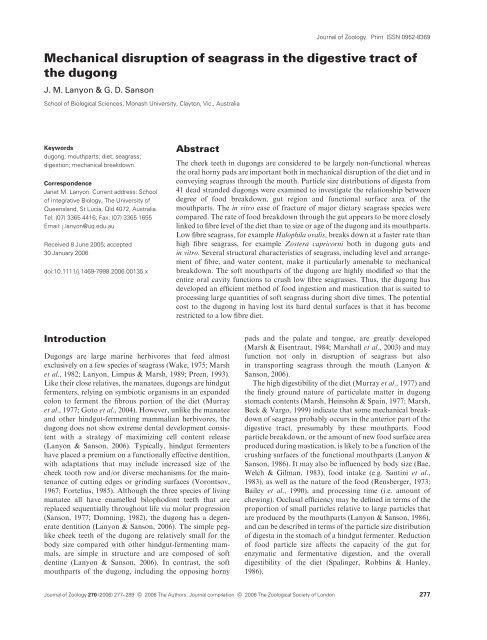


![Recycling [ PDF, 62KB ] - University of Queensland](https://img.yumpu.com/51805185/1/184x260/recycling-pdf-62kb-university-of-queensland.jpg?quality=85)
